Archive for August, 2011
Monday, August 29th, 2011
[The following article was initially published by Tigerquoll on CandoBetter.net on 20090730 under title ‘African Elephants – still slaughtered for tusk (‘ivory’) trinkets by backward Japanese and Chinese‘, with some modifications]
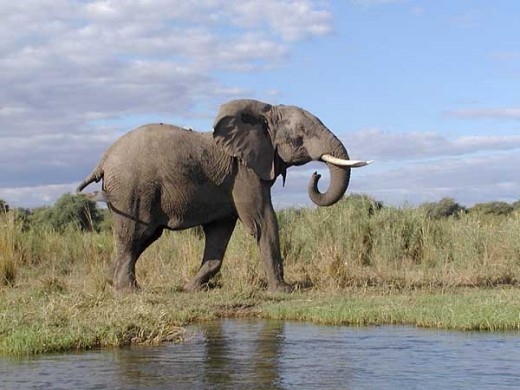 The magnificent African Bush Elephant bull (male) walking tall in its native savannah homeland
The magnificent African Bush Elephant bull (male) walking tall in its native savannah homeland
.
Out of Victorian colonial exploits of the 19th Century, elephant tusks could be found butchered and refined into expensive goods, notably billiard balls, piano keys, Scottish bagpipes, garment buttons, letter openers and for many ornamental items otherwise considered mere ‘trinkets’.
After the elephant tusk (‘ivory’) trade had decimated the African Elephant population from 1.3 million to 625,000, finally in 1989 the Environmental Investigation Agency (EIA) imposed a ban on this international elephant tusk (ivory) trade.
Ten years on, Zimbabwean dictator, Robert Mugabe, lifted the ban along with Botswana, Namibia, and South Africa and legalised the sale of elephant tusks from elephants they claimed (a) had died naturally or (b) been shot because they were violently aggressive or for ‘problem-animal’ control. In 1999, the Convention on International Trade in Endangered Species of Wild Fauna and Flora (CITES) authorized an auction of 50 tons of elephant tusks (ivory) from these four countries to the value of USD$5 million. Notably, the demand for elephant has been driven outside the African continent, in this episode mainly by Japan.
One could find a comparable solution for controlling Robert Mugabe…
 Tool of the Willing
(for just one day hire, …’our troubles there would be over very quickly’.)
~ borrowed from Colonel Walter E. Kurtz. Tool of the Willing
(for just one day hire, …’our troubles there would be over very quickly’.)
~ borrowed from Colonel Walter E. Kurtz.
.
In 2008, China was also given permission to become a licensed buyer of elephant tusks (ivory) and this followed 108 tons of elephant tusks (ivory) being auctioned from these same four African countries, representing the death of over 10,000 African elephants.
.
“The growing demand for elephant tusks (ivory) has increased black market prices from $200 per kilo to $850 per kilo in the past four years thus creating a big financial incentive for poachers. Michael Wamithi, program director for International Fund for Animal Welfare’s global elephants program, and former director of the Kenya Wildlife Service, declared: “An estimated 20,000 elephants are slaughtered annually for the trade in their tusks. Many African elephant range states clearly do not have the capacity or resources to combat these massive attacks on their countries’ wildlife heritage and the burgeoning markets in China are only fuelling these attacks.”
.
The Environmental Investigation Agency (EIA), which exposes environmental crimes, said CITES had ignored appeals from other African nations not to increase pressures on their elephant populations which were already struggling with wars, instability, droughts and poverty. EIA chairman Allan Thornton said:
“Responsibility for the poaching of 20,000 elephants in Africa each year will now lie with those who supported China obtaining legal ivory trade even though they continue to be the world’s biggest destination for poached ivory.”
 This elephant tusk (ivory) carving (photo) is a gift from China presented to the United Nations in 1974.
It depicts the Chengtu-Kunming railway, which was opened to traffic in 1970.
The sculpture was carved from eight elephant tusks. In elephant terms, four mature bull elephants were killed for this elaborate trinket. This elephant tusk (ivory) carving (photo) is a gift from China presented to the United Nations in 1974.
It depicts the Chengtu-Kunming railway, which was opened to traffic in 1970.
The sculpture was carved from eight elephant tusks. In elephant terms, four mature bull elephants were killed for this elaborate trinket.
One wonders whether the United Nations is still pleased with its eight bull elephant tusk trophy (shot and hacked off from a bull elephant like that above)?
.
.
Chinese, Japanese and Thais still Elephant Poaching in Africa
.
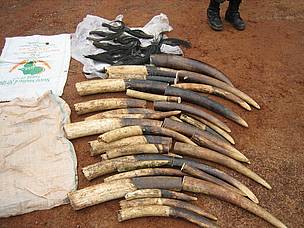
China and Japan bought 108 tonnes of ivory in another “one-off” sale in November 2008 from Botswana, South Africa, Namibia and Zimbabwe. At the time the idea was that these legal ivory sales may depress the price, thereby removing poaching pressure, an idea supported by both Traffic and WWF.
China’s increased involvement in infrastructure projects in Africa and the purchase of natural resources has alarmed many conservationists who fear the extraction of wildlife body parts is increasing. Since China was given “approved buyer” status by CITES, the smuggling of ivory seems to have increased alarmingly. Although, WWF and Traffic who supported the China sale, describe the increase in illegal ivory trade a possible “coincidence” others are less cautious. Chinese nationals working in Africa have been caught smuggling ivory in many African countries, with at least ten arrested at Kenyan airports in 2009. In many African countries domestic markets have grown, providing easy access to ivory, although the Asian ivory syndicates are most destructive buying and shipping tonnes at a time.
Contrary to the advice of CITES that prices may be depressed, and those that supported the sale of stockpiles in 2008, the price of ivory in China has greatly increased. Some believe this may be due to deliberate price fixing by those who bought the stockpile, echoing the warnings from the Japan Wildlife Conservation Society on price-fixing after sales to Japan in 1997, and monopoly given to traders who bought stockpiles from Burundi and Singapore in the 1980s. It may also be due to the exploding number of Chinese able to purchase luxury goods.
Despite arguments prevailing on the ivory trade for the last thirty years through CITES, there is one fact that virtually all informed parties now agree upon: poaching of African elephants is now seriously on the increase.’
.
.
‘Shopping habits of China’s ‘suddenly wealthy’
[Source: by Rose Gamble, freelance journalist, FT.com, 20090821, ^http://www.ft.com/cms/s/2/9271a266-8d21-11de-a540-00144feabdc0.html#ixzz1WPkaKde6, accessed 20110829]
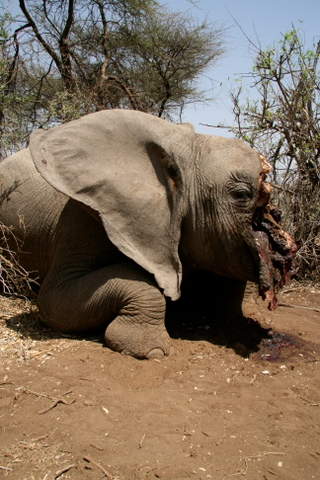
.
Ivory:
‘For more than 7,000 years, Chinese artisans have been crafting elephant ivory. Favoured by the Imperial household as far back as the Qing dynasty (1680), ivory has an illustrious reputation and an association with the wealthy and elite. But in 1989, the trading of ivory was banned worldwide through the Convention on International Trade in Endangered Species (Cites), after more than half of Africa’s 1.3 million elephants were poached in a single decade. And yet, with a carving trade established in antiquity and a burgeoning middle class who, for the first time, can afford to buy ivory, China remains its biggest importer.
As Asian elephant herds dwindle, African elephants have become the only source of ivory.
In late 2008, Cites authorities allowed China to bid with Japan for tusks from official stockpiles – consisting of ivory collected from elephants that had died a natural death – in four southern African countries. In an open declaration of a continuing demand, 12 Chinese traders bought 62 tonnes at an average price of $144 per kilo. Since this legal purchase, more than 11 tonnes of illegal African ivory have been impounded en route to China.
Elephant poaching largely takes place in central Africa, where poverty and political instability are rife. Chronic unemployment, the availability of firearms and corruption all facilitate the illegal ivory trade. These regions are also home to unregulated domestic ivory markets, where carved items are bought and sold. According to ivory expert Esmond Martin, the majority of buyers are Chinese. In a scramble for Africa’s minerals and resources, the continent has seen a recent influx of Chinese workers – a presence that is visibly reflected in the illegal retailing of ivory. On a recent trip to Addis Ababa, Ethiopia, Martin recorded 1,433 items of ivory openly displayed in the city’s main streets and central market. Among these were 149 pairs of freshly carved ivory chopsticks, selling for $16 each – in sharp contrast to a Chinese retail price of $139 – and signature stamps and jewellery. All of these items were small enough to potentially smuggle through customs.
Martin had previously estimated that 4,900 to 12,000 elephants from central Africa were killed each year to supply tusks to the craftsmen of Africa, China and Thailand.
Conservationists are deeply concerned. According to Barbara Maas, CEO of Care for the Wild International: “With the number of Chinese nationals resident in Africa rising, and poaching on the increase, the frontline between supply and demand for ivory is now perilously close, with a disastrous outcome for elephants.”
.
..
‘Campaigners’ fear for elephants, and their own credibility’
[Source: The Economist, 20080717, ^http://www.economist.com/node/11751304 ]
.
‘Nobody can deny that China’s black market was rampant until recently. In a report to the UN leaked by the Environmental Investigation Agency (EIA), a campaigning group, this month, Chinese officials admitted that between 1991 and 2002 they had lost sight of 121 tonnes of ivory, the equivalent of the tusks from 11,000 elephants.
Is China observing the CITES rules now? A brief visit to China in 2007 by inspectors from the CITES secretariat suggested that things had improved: they said that ivory was becoming harder to find, though they came across a shop in the city of Xi’an with ivory carvings of dubious provenance. A bigger investigation was carried out by TRAFFIC, an independent British-based group that monitors wildlife trade. After studying 10,000 shops between 2006 and 2008, it reported a progressive decline in the availability of illegal ivory. This had coincided with greater police vigilance.
The idea that China is cleaning up its act got another boost in March, when over 750kg (1,650lb) of raw ivory was seized in Guangxi Province. As CITES notes, the penalties for illegal trading include life imprisonment and death. But the EIA, which uses undercover methods to probe the trade, says things are not as good as they seem; in 2007 its researchers found a roomful of illegal ivory, including an uncut tusk, for sale in the city of Dalian. Last month they made a small find in Gansu province.
A more interesting question is how the legal sales now in prospect will affect the black market. A fresh supply of legal ivory may depress the price, and reduce the incentive to poach. TRAFFIC notes that after a legal auction in 1999, the price fell; this led to a decline in poaching over five years. For doctrinaire types, who oppose all trade in ivory, the forthcoming sale is not just a challenge to endangered animals; it could be a threat to the credibility of their best-loved arguments.’
.
.
‘Data shows illegal ivory trade on rise’
[Source: World Wildlife Fund (WWF), Cambridge, UK, 20091116, ^http://wwf.panda.org/wwf_news/?uNewsID=180702, accessed 20110829]
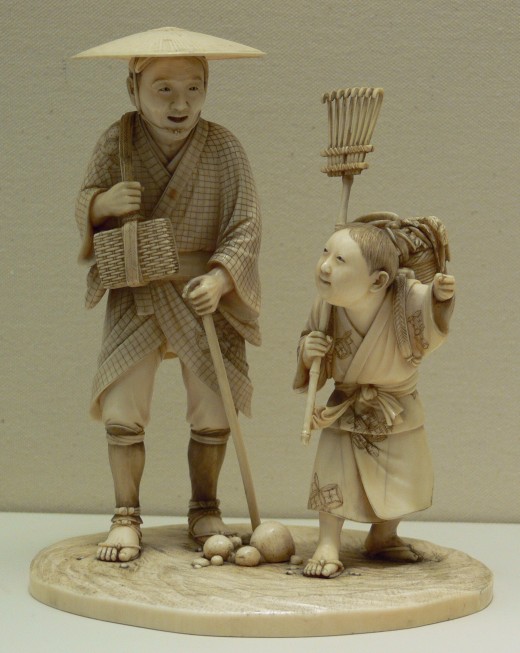
.
‘The illicit trade in ivory, which has been increasing in volume since 2004, moved sharply upward in 2009, according to the latest analysis of seizure data in the Elephant Trade Information System (ETIS).
ETIS, one of the two monitoring systems for elephants under CITES (the Convention on International Trade in Endangered Species of Wild Fauna and Flora) but managed by TRAFFIC, holds the world’s largest collection of elephant product seizure records.
The analysis, undertaken in advance of the 15th meeting of the Conference of the Parties (CoP15) to CITES, was based upon 14,364 elephant product seizure records from 85 countries or territories since 1989, nearly 2,000 more records than the previous analysis, in 2007.
The remarkable surge in 2009 reflects a series of large-scale ivory seizure events that suggest increased involvement of organized crime syndicates in the trade, connecting African source countries with Asian end-use markets. The ETIS data indicate that such syndicates have become stronger and more active over the last decade.
There continues to be a highly significant correlation between large-scale domestic ivory markets in Asia and Africa and poor law enforcement, suggesting that illicit ivory trade flows typically follow a path to destinations where law enforcement is weak and markets function with little regulatory impediment.
Indeed, the rise in illicit trade in ivory indicates that implementation of a CITES “action plan for the control of trade in African elephant ivory,” the Convention’s principal vehicle for closing such unregulated and illicit domestic markets in Africa and Asia, has failed to drive any significant change over the last five years.
The ETIS analysis identifies Nigeria, the Democratic Republic of the Congo and Thailand as the three countries most heavily implicated in the global illicit ivory trade. Illegal trade involving each of these nations has been repeatedly singled out for priority attention since the first assessment in 2002, but they continue to feature as critical hotspots in the trade as sources, entrêpots and consumers of ivory.
Another nine countries and territories—Cameroon, Gabon and Mozambique in Africa and Hong Kong SAR, Malaysia, the Philippines, Singapore, Taiwan and Vietnam in Asia—were also identified as important nodes in the illicit ivory trade.
China, which along with Japan was an approved destination of the legal, CITES-sanctioned one-off ivory sale in 2008, faces a persistent illegal trade challenge from Chinese nationals now based in Africa. Ongoing evidence highlights widespread involvement of overseas Chinese in the illicit procurement of ivory, a problem that needs to be addressed through an aggressive outreach and awareness initiative directed at Chinese communities living abroad.
The results are less clear-cut concerning the impacts of the CITES approved one-off ivory sales in 1999 and 2008.
Following the first such sale, in June 1999, there was a progressive decline in the illicit trade in ivory for five years, with no evidence to suggest that the sale had resulted in an increase in the illicit ivory trade globally.
After the second CITES-approved ivory sale, in late 2008, the results are unclear as to whether it has stimulated increase demand or whether it has simply coincided with an increase in supply that was already underway over the last four years. The collection of more data over an extended time period will throw further light on this vital issue.’
.
The full ETIS report can be downloaded from the CITES website as document at ^http://www.cites.org/common/cop/15/doc/E15-44-01A.pdf
[Read More]
.
.
‘China Fuels East African Elephant Poaching’
[Source: Damian Robin, Epoch Times, 20100330, ^http://www.theepochtimes.com/n2/content/view/32389/, accessed 20110829]
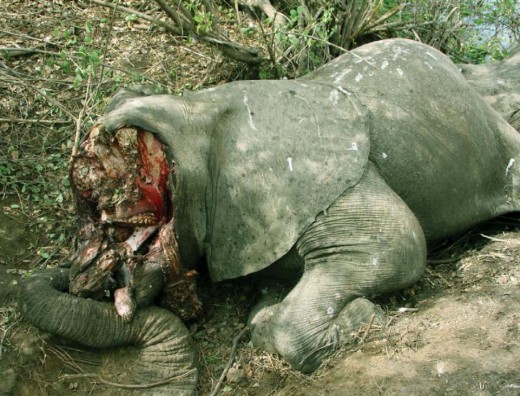
.
China’s influence in East Africa is fueling an upsurge in elephant poaching, gunrunning, and corruption according to a report on U.K. television Friday. A Channel 4 reporter spoke to people in villages and cities, wildlife managers, rangers, government officials, and illegal ivory sellers in Kenya and Tanzania—all of whom said China is the main buyer of banned ivory.
Filmed secretly, sellers told the journalist from Unreported World that during a presidential visit from Chinese Communist Party leader Hu Jintao in 2009, two hundred kilos of ivory was bought by Chinese diplomats and taken out of Tanzania.
The sellers did not say if Hu knew of the trade, but did say that a prominent diplomat from the Chinese Embassy frequently bought large amounts of ivory from them.
Kooky Gorman owns a wildlife park in Kenya. Accompanied by armed rangers, she took the reporter to many spots in her park, where elephant carcasses rotted, their heads split open to make it easy to saw the tusks off.
Many hides showed multiple bullet holes. The lead ranger said the killers had used AK47 automatic weapons to spray herds. The shootings were indiscriminate, killing young and old.
Gorman said the weapons were bought from neighboring Somalia where the civil war has continued since 1991.
The intensity of the poaching has been increasing for the past two years. In 2007 six elephants were poached from her park. In 2008, twenty-eight were poached. Fifty-seven were poached in 2009.
She says there is a threat of elephant extinction.
The Kenya Wildlife Service has strong rooms full of tusks and carved ivory taken during raids and confiscated at Nairobi airport. It has about 65 tons to 70 tons estimated at $10 million.
The U.N. recently rejected Zambia and Tanzania’s request to hold a one-off sale for their ivory stockpile, valued of approximately $15 million.
Since trade in ivory was stopped in 1989, some countries have been allowed to do a small amount of business in ivory if they have good conservation measures. Zambia and Tanzania are currently prohibited from any trade in ivory. The International Trade of Endangered Species of Fauna and Flora (CITES) annual meeting in Doha disregarded arguments that the sale could help police wildlife parks and stop the burden of protecting the horde of ivory.
Selous Game Reserve in Tanzania has 40,000 elephants.
On the TV program, a police informant who lived nearby in a village known for its illegal ivory deals said armed groups of 30 often came from Dara Salam in Senegal to take back ivory in 440-to-660-pound batches. (An average tusk weighs about 4.4 pounds.)
The informant, whose face was not shown for fear of reprisals, had had his house burned down recently.
Another man, who did not want to be identified as he had received death threats, was a safari operator who brings tourists to the Selous Reserve. “I think the wildlife department knows exactly what’s going on here,” he said. “There are some members of the games department who are poaching to supplement their pay and feed their families.”
He said he thinks movers are coming from China and the Far East to take bones and that they are in collusion with local authorities.
He said they could not get through the 15 to 20 policed roadblocks without help from “some very well-placed people.”
One illegal dealer said he had friends in airport security. “It’s no problem with money,” he told the reporter. “If you have money, it’s easy.”
There is a small industry carving the poached ivory for the East Asian trade. “Many people from China come and buy,” he said. There is a market for trinkets, seals, and chopsticks.
Chinese regime officials told Unreported World that they are against the illegal ivory trade and that Chinese diplomats did not illegally purchase or export ivory by misusing diplomatic immunity in 2009.
Most villagers have stood by while violence around the poaching continues. They felt threatened and were unable to prevent the elephant deaths. Now, many see tourism as the main way they can earn a living, so they are protecting the animals and habitat as much as they can.’

.
.
‘Ivory Stockpile Sale Rejected by U.N.’
[Source: Peter Valk, The Epoch Times, 20100324, ^http://www.theepochtimes.com/n2/content/view/31944/, accessed 20110829]
.
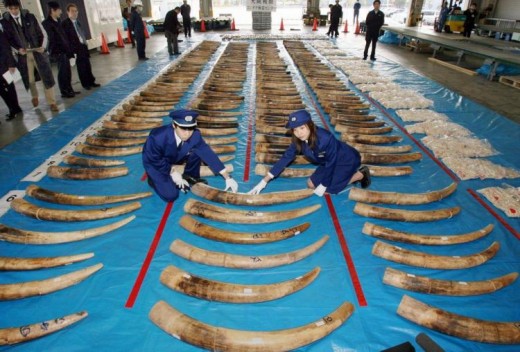 Custom officers display a total of 2.8 tons of ivory on March 1, 2007, a record amount seized in Japan, a top black market destination for elephant tusks.
The U.N.’s Convention on the International Trade of Endangered Species of Fauna and Flora rejected Zambia and Tanzania’s request to sell it’s stockpile of ivory.
(AFP/Getty Images)
. Custom officers display a total of 2.8 tons of ivory on March 1, 2007, a record amount seized in Japan, a top black market destination for elephant tusks.
The U.N.’s Convention on the International Trade of Endangered Species of Fauna and Flora rejected Zambia and Tanzania’s request to sell it’s stockpile of ivory.
(AFP/Getty Images)
.
‘Zambia and Tanzania’s request to hold a one-off sale for their ivory stockpile, valued of approximately $15 million, were rejected during the U.N.’s Convention on the International Trade of Endangered Species of Fauna and Flora (CITES) annual meeting in Doha. The increase of poaching and illegal ivory sales in both countries in 2009 were the main reasons for the rejection.
Since the ivory trade was banned in 1989, there has been an exemption that allows countries that have proven effective in conservation measures to have a small amount of regulated trade in ivory. Currently, Zambia and Tanzania are forbidden to sell ivory.
“It’s crucial that central and western African nations suppress the brazen poaching, mainly fueled by organized crime and illegal ivory markets openly operating within their borders before any further ivory sales take place,” said Sybille Klenzendorf, managing director of Species Conservation at WWF-U.S. in a press release.
According to a report from the Elephant Trade Information System (ETIS), which keeps track of ivory seizures, there exists a direct relationship between an increase in poaching and poor law enforcement. In the past two years, the number of elephants that were killed as a result of poaching has quadrupled.
Opponents of the ban say that Tanzania ought be allowed to dispose of their ivory stockpile as to avoid spending large sums of money on security and storage.
During the meeting, in which 175 countries participated, some animals were added to the list of protected species. The rise of e-commerce is now believed to be one of the latest and biggest threats to wildlife, as global Internet access has made it increasingly easy to buy and sell illegal wildlife products with little control.
“The transactions kind of come and go and take place before anybody really even knows it, leaving it to the post office to be enforcing this global regime of trade regulation,” Paul Todd, a campaign manager for the International Fund for Animal Welfare (FAW) was reported as saying by ABC news in Australia.
Back in 2005, a FAW investigation reported that in one week alone, over 9,000 live animals or products in five categories of animals were for sale on English-language Web sites, chat rooms and the popular auction site eBay. Some of the live animals found included a gorilla in London, and a Siberian tiger in the U.S. Body parts and products were also commonly found with ivory being common.’
.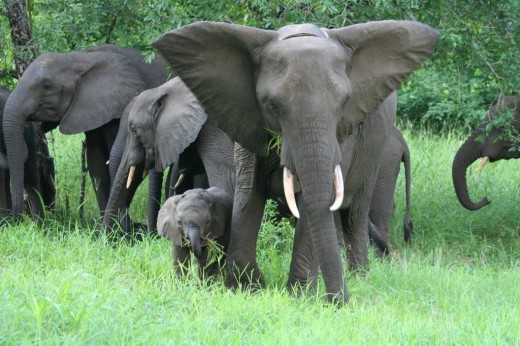
An African Elephant herd
(click photo to enlarge)
Elephants are very intelligent, lifelong loyal and have immense family bonds.
A female elephant listens and watches the photographer intently, with her young close to her side.
An elephant mother will protect her calf to her death.
.
.
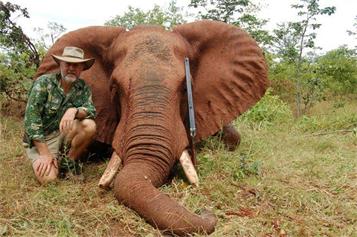 Australia’s big ‘game hunter’, Robert Borsak in Zimbabwe (2008)
Australia’s big ‘game hunter’, Robert Borsak in Zimbabwe (2008)
.

‘Macdonald’s game council thrill killer‘
by Andrew Clennell, State Political Editor, Sydney Morning Herald, 20090721, ^http://www.smh.com.au/environment/conservation/macdonalds-game-council-thrill-killer-20090720-dqui.html]
.
Robert Borsak (on the NSW Government’s Game Council) went to northern Zimbabwe to hunt elephants. On a two-week trip he killed several, including a bull elephant he shot in the head from a distance of six paces.”My reflexes took over as the rifle fired … he went down, as if in slow motion,” writes Mr Borsak in an article entitled Bulls in the Rain posted on the internet. “It was awesome. He did not know what had hit him.”Back in Australia, Mr Borsak has bagged another prize. The big game hunter and former vice-chairman of the Shooters Party is being paid $342 for each sitting day as chairman of the Game Council of NSW, one of 58 quangos which operate under the Primary Industries Minister, Ian Macdonald.
Mr Borsak hopes to run for the Shooters Party at the next election. If successful, he would join a party that now holds the balance of power in the upper house and is holding the Government to ransom after Mr Macdonald failed to negotiate through cabinet the right to shoot in National Parks.It is an example of the kind of interests the embattled Mr Macdonald is accused of helping to protect in some of the committees and statutory bodies he oversees.Mr Borsak is being paid $342 a sitting day for his part in regulating hunting in this state. Conservationists say the Game Council’s only purpose is to win the Shooters Party votes.Last week there were revelations the minister spent close to $150,000 on a wine industry council he set up, chaired by his friend Greg Jones; and that the minister had put other Labor identities – such as union boss Russ Collison and former Labor MPs – on quangos.The Herald learned yesterday Mr Macdonald appointed a friend of 25 years, John Gerathy, the law partner of former Labor deputy prime minister Lionel Bowen, to the wine council and the Homebush motor racing board.
Mr Macdonald is under siege. Yesterday the acting Opposition Leader, Andrew Stoner, referred him to the Independent Commission Against Corruption over claims he gave special treatment to another Labor mate, the former construction union president John Maitland, over granting an exploratory licence for a Hunter Valley mine.
The Premier, Nathan Rees, refused to comment yesterday when asked if the Left assistant secretary Luke Foley, who wants Mr Macdonald’s upper house seat, would be a better cabinet minister than Mr Macdonald.
As for Mr Borsak, he was resentful yesterday that he might be included in a story to do with Mr Macdonald.
The Game Council has received more than $11 million in government funding since 2002 and $3.5 million last year, despite promises from Mr Macdonald it would end up being self-funded.
Mr Borsak said the Game Council was set up in 2002, before Mr Macdonald was minister, and should not be lumped in with other committees as it was a statutory body. He said he was a businessman who received “a grand total of $1368 for last financial year for about 60 days’ work for the council”.
“Why would there be a conflict of interest,” Mr Borsak said, when asked whether his involvement in the Shooters Party might mean he should not be involved in the Game Council. He said of the Zimbabwe hunt: “The fact is I do it [the hunt] and I do it legally and I did it as part of licensed conservation programs. The … tusks belong to the Zimbabwean Government.”
The executive director of the Nature Conservation Council, Cate Faehrmann, said it was time the Game Council’s “activities were thoroughly scrutinised”.
Mr Maddonald’s “aggressive support of the establishment of game reserves and hunting in National Parks is all the more insidious when you realise at least one of the people behind this push likes to kill elephants in his spare time,” she said.
“By pumping millions of dollars into the Game Council, Minister Macdonald is sanctioning bloodsports.”
Mr Stoner called for Mr Macdonald to be sacked. “It seems every day there are more doubts raised about Ian Macdonald … There will be more, so Nathan Rees should do the right thing and sack this minister.”
.
.
‘The cruelty and corruption of the elephant hunt’
[Source: Sydney Morning Herald, following letters to the editor, 20090722, ^http://www.smh.com.au/environment/conservation/the-cruelty-and-corruption-of-the-elephant-hunt-20090722-dtb3.html]
.
Letters to the Editor
‘I began hunting as soon as I was old enough to use a rifle. But the photo of Robert Borsak gloating over the body of an elephant he shot in Zimbabwe fills me with disgust (“Macdonald’s game council thrill killer”, July 21).Zimbabwe is one of few African countries to allow this practice. People typically pay about $US20,000-$26,000 ($25,000-$32,000) for this privilege. Bulls are more expensive, presumably because of their tusks. Where does this money go? Here is a hint.
Advertisement: Story continues belowThe BBC reported a decade ago that the government of Robert Mugabe earned US$2.5 million by selling 20 tonnes of elephant tusks, although the ivory trade had been banned. Zimbabwe lies about its elephant population to get around the ban. This practice is probably greater today.As the economy collapsed, the Zimbabwean Army, the key to Mugabe’s survival, cancelled all contracts to supply beef. The Zimbabwean Conservation Task Force reports soldiers have complained the only meat they are given is from elephants. So in addition to the immense pleasure Borsak apparently feels in the senseless destruction of a great creature, he can also take pride in doing his bit to keep Africa’s worst despot in power.’~ Don Moore, Lilyfield
.
.
‘I loved the juxtaposition of the stories about Robert Borsak, and Sining Wang and Edward Liew (“Don’t have a cow man – it’s got rights”, July 21). Thank heavens for the next generation of intelligent and compassionate thinkers. I hope it is only a matter of time before Wang and Liew can flex their legal muscles against thug shooters such as Borsak. The sooner they are banned from indulging in their cruel and destructive hobbies, the better.’~ Belinda Connolly, Caringbah
.
.
‘It has been said that people get the politicians they deserve.What does it say about the people of NSW when there is a danger of Robert Borsak standing for a seat in Parliament – a man who admits to the thrill of downing a bull elephant “from a distance of six paces”?’Jill Klopfer, Wahroonga
.
.
‘So Robert Borsak killed elephants in Zimbabwe “as part of licensed conservation programs”.The corrupt Zimbabwean Government and conservation are complete strangers, as anyone who has anything to do with trying to save what is left of Zimbabwe’s wildlife can tell you.’Colleen Riga, Potts Point
.
.
‘Robert Borsak says “the tusks belong to the Zimbabwean Government”. No – the tusks belong to the elephant.’Jean-Marc Russ, Darlinghurst
.
.
‘It comes as no surprise to learn of Ian Macdonald’s patronage of hunters. The minister has shown scant regard for the welfare of animals, as those of us working in animal charities can attest. His $3.5 million for the Game Council compares with the $533,000 in funding he announced in April to be split between the RSPCA, Animal Welfare League, WIRES, Cat Protection Society and the Domestic Animal Birth Control Co-operative Society.The Government opposes Clover Moore’s bill to reduce the suffering of cats and dogs by regulating their sale, and even pleas for an inquiry into the welfare of companion animals have been rejected. A minister who gives priority to working with a hunter who describes shooting an elephant as awesome is hardly likely to care that tens of thousands of cats and dogs are killed annually on his watch.’
Kristina Vesk chief executive, Cat Protection Society of NSW, Newtown
.
– end of article –
Tags: African Elephant, Chinese illicit ivory trade, cites, Convention on International Trade in Endangered Species of Wild Fauna and Flora, Environmental Investigation Agency, illegal ivory trade, Ivory trafficking, ivory trinkets, Japanese illicit ivory trade, Robert Mugabe, Selous Game Reserve, Thai illicit ivory trade, TRAFFIC
Posted in Africa, Elephants, Threats from Poaching and Poisoning | 1 Comment »
Add this post to Del.icio.us - Digg
Monday, August 29th, 2011
 The magnificent tiger in the wild, where it belongs,
free, protected from humanity, protected from human persecution, protected from backward superstition.
A big ask of a pathogenic backward species ~ homo ‘sapiens’? The magnificent tiger in the wild, where it belongs,
free, protected from humanity, protected from human persecution, protected from backward superstition.
A big ask of a pathogenic backward species ~ homo ‘sapiens’?
.
“I hold that the more helpless a creature, the more entitled it is to protection by man from the cruelty of man”
.
“The greatness of a nation and its moral progress can be judged by the way it treats its animals.”
~Mohandas Gandhi (1869-1948)
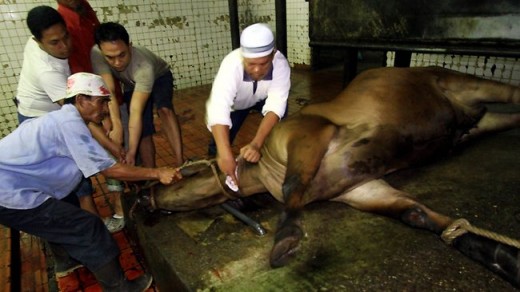 By this measure, Indonesian society’s prescription and tolerance of Dhabiha throat slitting slaughter in its abattoirs reflects a society that is barbaric, immoral, uncivilized and backward. By this measure, Indonesian society’s prescription and tolerance of Dhabiha throat slitting slaughter in its abattoirs reflects a society that is barbaric, immoral, uncivilized and backward.
.
.
Then we have the backward cultural practice of Traditional Chinese Medicine (TCM):
.
‘Diplomat exposed Chinese tiger farm horrors’
[by Jonathan Watts, 20110827, The Age newspaper, borrowed in turn from The (UK) Guardian News & Media, ^http://www.theage.com.au/environment/animals/diplomat-exposed-chinese-tiger-farm-horrors-20110826-1jefp.html, accessed 20110829]
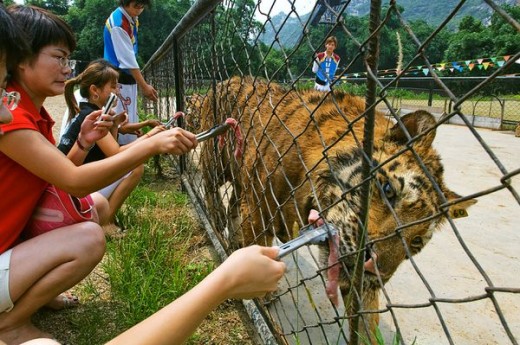 Chinese tormenting a Xiongsen Tiger Chinese tormenting a Xiongsen Tiger
.
‘An American diplomat posed as a Korean tourist to investigate a notorious tiger breeding centre in southern China, where he saw animals whipped, made to perform ”marriage processions” and reportedly sold to be used in traditional medicines.As a result of the undercover visit to Xiongsen Tiger and Bear farm, the US government was notified of doubts about China’s conservation efforts, according to a diplomatic cable recently released by WikiLeaks.
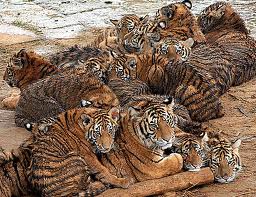 Xiongsen Tiger – a pitiful end Xiongsen Tiger – a pitiful end
The investigation was inspired by a flurry of foreign media reports in 2007 alleging the farm offered tiger meat in its restaurant and tiger bone wine in a shop.
In a cable sent from the Guangzhou US consulate headed ”Devouring Dragon, Disappearing Tigers”, an un-named economics officer said he was initially treated with suspicion by the sales personnel in the facility. But once he convinced them he was Korean, they became eager to do business.
”The staff stated that up to three tour groups of Koreans came a day, numbering more than 30 in each group.The Koreans were among the most enthusiastic purchasers of both the black bear bile and the tiger wine.” The price of the bottles ranged from 80-896 yuan ($12-$134).
 Tiger Parts used by in barbaric chinese superstition (TCM) Tiger Parts used by in barbaric chinese superstition (TCM)
.
China says it has nearly 6000 tigers in captivity, but only 50 to 60 are left in the wild. In the 1980s, China set up tiger farms to try to preserve the big cats. But conservationists have criticised the farms, accusing them of seeking primarily to produce tiger parts, which some Asians regard as aphrodisiacs.
 Packaged Traditional Chinese ‘Medicine’ Packaged Traditional Chinese ‘Medicine’
[About as effective as eating garden snails]
.
The visitor to the farm – which has more than 1000 tigers in its cages – described the spectacle of a tiger killing an ox in a ”training cage” purportedly set aside as a training area for animals that are to be introduced to the wild. But most of the animals appeared tame and some were used in circus-like entertainment shows, where they were beaten. Black bears – kept for their bile – were also made to join a mock Chinese marriage procession where they acted as bride and groom, he wrote.
 Xiongsen Bear and Tiger Mountain Village
(a backward cruel colosseum for human hedonistic animal sadism) Xiongsen Bear and Tiger Mountain Village
(a backward cruel colosseum for human hedonistic animal sadism)
.
Locals told him that the farm served tiger meat and sold tiger skin, but this was denied by staff.
Nonetheless, he concludes in the cable dated July 12, 2007, that:
”The commercial nature of the farm was troubling. The large number of endangered tigers and bears present with no current plans to reintroduce them into the wild raises concern regarding the motivation of such a farm.”
.
Four years later, these concerns remain valid. Reports earlier this year suggest the tiger population of the farm has grown.’
.
 A threatened and persecuted species by backward human cultures,
reduced to the mercy of civilized humanity’s compassion and whim. A threatened and persecuted species by backward human cultures,
reduced to the mercy of civilized humanity’s compassion and whim.
.
 Gong Xi Fa Cai
[Chinese Year of the Tiger ~ a harbinger of mass slaughter] Gong Xi Fa Cai
[Chinese Year of the Tiger ~ a harbinger of mass slaughter]
.
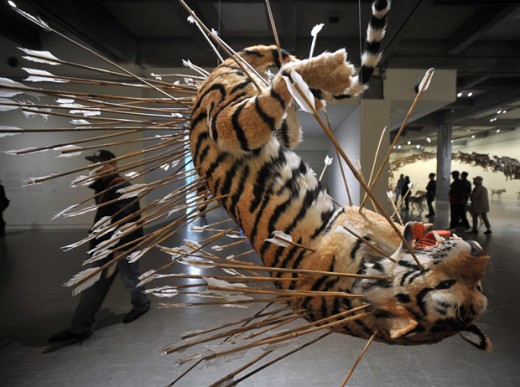 2010 was the Chinese Zodiac Year of the Tiger 2010 was the Chinese Zodiac Year of the Tiger
.
.
Footnote
 Rare photo of a Caspian Tiger Rare photo of a Caspian Tiger
.
Until the 19th century, Caspian tigers still inhabited wide spaces of Western and Central Asia. In the mid-19th century, Caspian tigers were killed 180 km northeast of Atbasar, Kazakhstan and as far North as near Barnaul, Russia.
The only reported Caspian tiger from Iraq was killed near Mosul in 1887. In 1899, the last Caspian tiger near the Lop Nur basin in Xinjiang, China, was killed. Caspian tigers disappeared from the Tarim River basin in Xinjiang, China, by the 1920s.
The last record of the Caspian tiger on the Ili River, their last stronghold in the region of Lake Balkhash, Kazakhstan, dates to 1948.
 Caspian Tigers now are extinct. They only exist in illustration. Caspian Tigers now are extinct. They only exist in illustration.
.
.
– end of article –
Tags: backward cultures, Chinese Tiger Farm, Dhabiha, Indonesian abattoirs, TCM, tiger bone, tiger parts, Traditional Chinese Medicine, WikiLeaks, Xiongsen Bear and Tiger Mountain Village, Xiongsen Tiger, Xiongsen Tiger and Bear farm, Xiongsen Tiger Mountain Village
Posted in Threats from Poaching and Poisoning, Tigers | 1 Comment »
Add this post to Del.icio.us - Digg
Sunday, August 28th, 2011
The following article was initially published by Tigerquoll on CanDoBetter.net 20090416 under the title: ‘ACT Environment Commissioner unqualified to condemn kangaroos’:
.
One day kangaroos grazing on Australian grasslands (long deforested by colonists)…
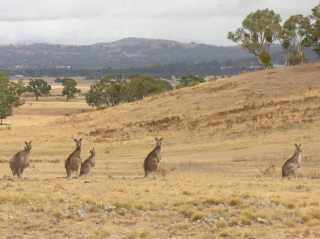
Next day, thanks to the ACT Commissioner for Sustainability and the Environment….

ACT Commissioner for Sustainability and the Environment, Dr Maxine Cooper, is the Australia Capital Territory’s inaugural full-time Commissioner in the role, yet what relevant environmental qualifications and experience does the incumbent have, or indeed lack, to be officially condemning another local indigenous population of Australia’s iconic marsupials, our kangaroos, to slaughter for pet food?

The Environment Commissioner’s own website lists her formal qualifications in the areas of:
- Environmental Planning
- Environmental Design
- Environmental Science
.
All these ‘environmentally’ friendly prefixes sound impressive, until one realises that each of these areas of academic study are not fauna focused, but indeed are all about human-centric utilisation of the natural environment for the benefit of humans. That is, these qualifications are all about maximising the convenience of the environment for humans. A wolf in charge of the kangaroos? It’s just like forestry pretending to care about forests.
Such qualifications offer no insight into the survival and habitat needs of Australian wildlife. “According to ACT’s inaugural Environment Commissioner, kangaroos at Belconnen were a threat to certain vulnerable and endangered species of fauna and flora on the site. Where’s the bloody independent zoological evidence, who would attest to this view under the test of peer scrutiny?
Now if our roo-shooting redneck commissioner had a more relevant Bachelor of Science in Zoology from say the University of Melbourne, she may be of a contrary mindset and less aligned to human planning needs and monetary gains; instead more empathetic to ecological needs of native fauna. The introductory paragraph for the University of Melbourne’s Honours degree in Zoology instills the following focus:
.
“How animals live and why they live that way are questions addressed by zoologists. Most of the Australian fauna are poorly understood or not even formally named, yet informed management and resource use of Australia’s flora, fauna and habitats depend upon zoological knowledge. We need to catalogue what species exist and how they survive in their natural environments. This requires knowledge of their physiology, breeding and reproductive systems, ecology, evolution and behaviour.”
[SOURCE: http://www.unimelb.edu.au/HB/areas/SZOOL.html]
Maxine Cooper, where are your qualifications in Zoology, in Conservation and in Australian wildlife to entitle you to officially condemn thousands of Australia’s iconic kangaroos to slaughter for cat and dog food?
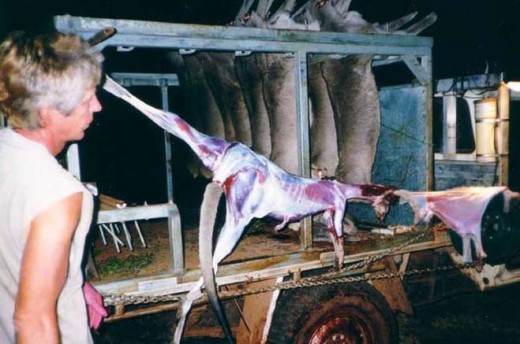
Can you guarantee the Australian public that none of these kangaroos is to be minced for cat and dog food?
The standard setting for the job prerequisites for the ACT’s Environment Commissioner are woeful and clearly not in the best interests of the target subject – our natural wildlife. What were they thinking by employing a planner in environmental management?
.
.
.
Editor’s comment:
.
The stated role of the OCSE is to:
.
- ‘Investigate complaints about the management of the environment by the Territory or a Territory authority’
- ‘Conducts investigations as directed by the Minister’
- ‘Initiates investigations into actions of an agency where those actions would have a substantial impact on the environment of the ACT’
- ‘Produces state of the environment reports for the ACT and the 17 councils in the Australian Capital Region’
- ‘Makes recommendations for consideration by government and includes in our annual report the outcomes of those recommendations’
- ‘Resolves issues through mediation and conflict resolution’
- ‘Undertakes an advocacy and awareness role on sustainability and environmental issues.’
.
[Source: OCSE website, ^http://www.envcomm.act.gov.au/our_office]
.
So it basically seems to be an ACT Government environmental watchdog agency. Why?
The ACT covers only 2400 square kilometres and has under 400,000 people. It already has an Environment and Sustainable Development Directorate [Read More], which lumps disparate functions under one watered down super-ministry including environment, water, climate change, planning (including development assessment, leasing, construction, land use and utilities regulation, surveying and land information), the Government architect, heritage, transport planning and nature conservation.
So is OCSE the watchdog for one overburdened super-ministry? It is bureacracy gone mad. Since Canberra is the seat of the federal government and ACT is so small, why not just have the Federal Government look after ACT conservation matters and be cost effective with taxpapers’ money?
.
It is gross deceptive greenwash when the Australian Capital Territory government merges all its conservation responsibility into one super agency, The Office of the Commissioner for Sustainability and the Environment, (OCSE), then heads it up with a town planner [Read More], then tries to claims that it has custodial responsibility for environment and conservation on behalf of the people of the ACT. It is wholly consistent with government’s misuse and abuse of the word ‘sustainability‘ ~ to mean any action that sustains the government’s conveniences and political ends, such as land use development of grasslands for industry. The Office is simply a development planning arm of the ACT Government and many Canberra-based property developers are very happy with the arrangement thank you very much.
But it is the biased leading the inept when one reads a report, ‘Report of the Grassland Forum‘ dated 20 May 2010 on the website of this Office of the Commissioner for Sustainability and the Environment.
The report considers the future potential of the 10,000 hectares of native grassland just outside Canberra.
This report was not compiled not internally (probably because the OCSE employs not competent environmental scientists to do so), but believe it or not by a property development consulting firm ‘Beaconhill Consulting‘. ‘Beaconhill Consulting’s recent work is listed on its website as:
- Strategic performance review of a major multi-program investment portfolio valued at several hundred million dollars
- Due diligence examination of a multi-million dollar import business investment – supply chain and market analyses, review of product efficacy and policy framework
- Strategic Business Development for an emerging export business – Board level reforms and strategies, business plan development, commercialisation strategy, marketing plans, industry development application, governance arrangements and commercial partner negotiations
- Business Development, government submissions, marketing plans, and client tenders.
.
The ‘Report of the Grassland Forum’ “found that the Eastern Grey Kangaroos are the dominant herbivore in natural grasslands..and that their overgrazing has lead to erosion and loss of plant species“.
It is not surprising that the Maxine Coopper’s office has approved many hundreds of these native kangaroos have been conveniently slaughtered for pet food. Some nutter has even contrived a myth that these grazing native kangaroos are threatening the survival of a rare native Earless Dragon in the area. Kangaroos threatening native animals! That’ a cracker! The fact that thousands of hectares of these grasslands are planned for bulldozing to make way for industrial and residential development may not threatend the Earless Dragon is not mentioned in the report.
It is laughable to read terms such as ‘diversity‘ and ‘ecology‘ used in the report in the context of industrial development.
The study focused upon Canberra restricted supply and diversity of industrial land. It is considered that Eastern Broadacre will play a critical role in meeting Canberra’s industrial needs in the long term. The study found that possible uses include:
- Freight/ transport and logistics
- Industrial and associated office
- Warehousing/ storage
- Education and training facilities
- Tourism/ recreational uses
‘Belinda explained that the sustainability corridors may have broader considerations, and ACTPLA is keen to explore light industry ecology.’
.
[ Read Report]
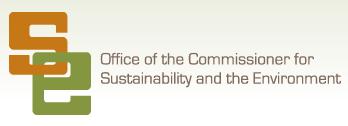
So this is where the tax revenue of the people of Australia’s Capital Territory around Canberra is being spent. How much did this report cost? How much did the OCSE logo above cost – took a lot of imagination that one!
Tags: ACT bureaucracy, ACT Commissioner for Sustainability and the Environment, ACT taxpayers money wasted, Dr Maxine Cooper, Eastern Broadacre, Eastern Grey Kangaroos, Environment and Sustainable Development Directorate, greenwash, kangaroo meat, kangaroo pet food, kangaroo slaughter, Report of the Grassland Forum, save the kangaroo, the biased leading the inept, Visit Canberra
Posted in Kangaroos and Macropods, Threats from Poaching and Poisoning | No Comments »
Add this post to Del.icio.us - Digg
Saturday, August 27th, 2011
The following ultra-short article was initially published by Tigerquoll on CanDoBetter.net 20090507 under the title: ‘Premier John Brumby – a man of principle, a ‘year of action’ logging Old Growth at Bungewarr Creek‘
.
Senseless slaughter of Victoria’s Old Growth..another Brumby legacy for Victoria
29 April, 2009:
The result of senseless logging at iconic Bungewarr Creek, far East Gippsland. Loggers have desperately chainsawed magnificent stands of ancient Australian Eucalypts along Bungewarr Creek in East Gippsland as the woodchips, allowing our natural heritage to be sold out to the Japanese for a despicable $2.50 per tonne!
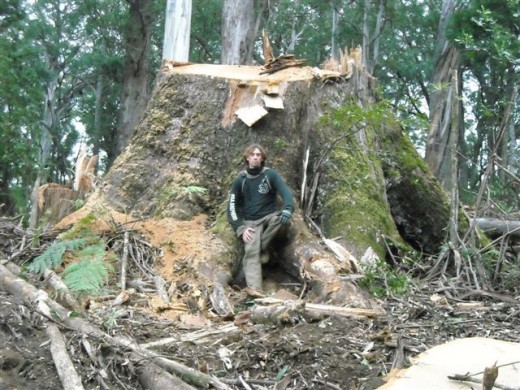
“Two protesters are ‘flying’ a platform located thirty metres up in the tree canopy”.. “this platform is cabled off to four logging machines, immobilizing them.”
First blockaded in 1994, Old Growth at Bungewarr Creek has been targeted by loggers ever since. Premier John Brumby simply cannot be trusted with Victoria’s natural heritage.
.
.
Subsequent Comments:
.
‘Sell the loggers not the logs’
On May 7th, 2009 Sheila Newman replied:
Maybe these stooges for big companies would get more money selling the loggers?
Sheila Newman, population sociologist
.
.
‘Rampant materialism and environmental destruction!’
On May 7th, 2009 Vivienne replied:
About 90% of what comes out of our old-growth forests ends up as woodchips to make paper, the majority of which is sent overseas. The “management plan” for Tasmania’s Upper Florentine Valley means a growing logging industry for wood chips, with a current price a mere $2.50 per tonne!
Despite the area being surrounded by mountains of the Tasmanian World Heritage Area, the Colonial ignorance of slash and conquer the bush has changed little since the last Tasmanian Tiger was captured there in the 1933.
All this so-called “sustainable forest management” is just thinly disguised eco-destruction by Tasmania’s logging industry.
We are bombarded with ecologically “friendly”, “sustainable” and “green” language, but the euphemisms are totally contrary to everything they claim!
We are encouraged to avoid plastic bags, turn off power when it is not needed, use energy-friendly light bulbs, save water, use public transport, but the benefits of these actions belie the fact that our governments continue to support the large polluters and industries that are adding to climate change and conservation threats!
Our leaders must be held accountable the rampant materialism and environmental destruction that our nation is succumbing to.
.
.
‘Logging contracter attacks Bungewarr protesters’
On May 9th, 2009 jim barton replied:
i have lost several thousand dollars in income due to the pathetic protests the greens have undertaken over the last 2 weeks in the bungewarr area. If you have a problem take it up with the state government directly or the vic forests office. No one will ever take you seriously while you are illegally chained to a machine or strung up a tree stopping the people who are there to make money to feed our familys. Do you honestly think the state government gives a shit while you are taking this sort of illegal action? The only people losing out are the loggers by taking away a slab of our income, the easily led pawns the greens send in to the protests that come out feeling like heroes but now have a criminal record for life. Also not to mention the tens of thousands of tax payer dollars that get spent on the police rescue squad coming from melbourne just to release the protesters and also the local police time wasted. Start using your brains and be a little more democratic and also start telling people the truth about our logging practices instead of just the lies you make up to sway the public to your way of thinking. Old growth forest dosn’t absorb carbon dioxide like you say so if you want to get technical we can say that we are helping climate change by replacing it with smaller re growth that with filter the atmosphere a lot more efficiently. This is a saw log driven industry, the pulp that goes for wood chips is what is left over from the tree after the saw log has been taken. Stop the lies and the pathetic protests because no one listens when you go about it in this way. Your protests are just an excuse for camping up the bush smoking dope, dancing around a fire by night, then during the day trying to fighting for a cause that not that many of them really know that much about.
.
.
‘State Government does not listen to decent protests!’
On May 9th, 2009 Jose replied:
Extreme protests are because our State Government is only interested in money and the votes of businesses, and jobs for forest workers. Extreme protests gets the public and the media’s attention. The income of loggers is a minor and short-term affair. These old-growth forests and trees have been here since Columbus discovered America, or before! They have TIME and GREATNESS on their side, and these stalwarts stand as sentinels against the wreckage that humans in power want to inflict on them, for a paltry $2.50 per tonne! They store massive amounts of carbon, and chopping them down is environmental vandalism. Get a job, Jim Barton! Nobody accepts the green-washing bulls**t our State government comes out with! They are all lies.
.
.
‘VicForests no different to Indonesian Timber Mafia’
On May 11th, 2009 Tigerquoll replied:
Illegal logging involves “wood harvesting, processing and trade that do not conform to law. Illegalities occur right through the chain from source to consumer, the harvesting procedure itself may be illegal, including corrupt means to gain access to forests, extraction without permission or from a protected area, cutting of protected species or extraction of timber in excess of agreed limits. Illegalities may also occur during transport, including illegal processing and export as well as mis-declaration to customs, before the timber enters the legal market.”
Other examples of illegal logging are:
* Under-reporting harvest volumes and tax payable
* Ignoring selective cutting guidelines
* Harvesting outside concession boundaries
* Falsifying log transport documents
* Accepting falsified log transport documents
Timber can also be considered illegal if the plantations are not properly managed.
This includes:
* Clear-cutting natural forest, then failing to replant
* Not planting at rates required to maintain long-term production
* Replanting with low-quality species
* Replanting at low density.”
SOURCE: http://www.abc.net.au/4corners/content/2002/timber_mafia/resources/resources_illegal_logging.htm
So perhaps Jim Barton can explain the forest impact difference between VicForests endorsed slaughter of Australia’s heritage old-growth at Bungywarr Creek and at Brown Mountain in East Gippsland and what the Indonesia’s Timber Mafia are doing?
.
.
‘More Lies’
On May 12th, 2009 jim barton replied:
Righto jose and tigerquoll lets get a few things straight. first and foremost, i have a job. i am a logger currently logging the bungewarr creek area incase you didn’t read my first piece properly. Secondly, tigerquolls new name is now guinea pig because thats what he looked and sounded like when he was running back for cover into the bush at last weeks tax payer funded protest when we wanted to talk to him. It is bullshit for you dole bludgers to say that loggers incomes are not an important issue when it comes to this arguement. That’s rich considering most of the protestors don’t have jobs and live off the money i pay in tax every week, therefor you are living off the tax money earned through logging old growth forests and that alone increases your carbon foot print when you trace it back! Like it or not the logging practices we undertake are as much as you may dislike the idea, legal. You may need a little thing the police call evidence if you want to go throwing unproven and rediculous claims at us. You can check every single log docket, boundary marker and all other relevant paperwork if you like. All you will find is a legal harvesting procedure that has complied with the legal requirements and documentation that vic forests and our state government has specified, planned and employed us under and therefor endorsed. You can throw your big words, lies and acusations around all you like but at the end of the day no laws are being broken apart from the ones you break by trespassing into a public safety area and holting work for a few hours. like i have said everyone is entitled to an opinion, maybe you need to voice yours through the proper authorities. Maybe then people will listen because illegal action will never conquer legal works. By the way, old growth trees have been proven not to produce oxygen after a certain age and also stop absorbing carbon dioxide. look it up. We do not falsify log dockets as that is what we are payed by. We do not underreport the amount of timber harvested for tax reasons as we are liable to penalties from vic forests if we do not cut the contracted volume of wood. We do not harvest outside boundaries as that can lead to penalties that in tern end up costing us money. Vic forests and the dse burn the finnished coupes to stimulate seed germination and growth (replanting). Areas are regenerated at rates to ensure that the area is sufficient for the next round of log harvesting. Finally, the correct species are replanted at the correct density to ensure the bush grows back to meet harvesting, legal and environmental standards. And to your final question guinea pig, our logging practices are not illegal due to the fact that the people in our crew comply with australias rules and regulations on the correct procedures for timber harvesting. Indonesias logging is illegal due to the fact that they enter an area to take timber without the correct permits and by buying the governments silence through kick backs from the profits of these illegal activities. Logging old growth is only illegal in your minds because you let emotion and centiment cloud your already hazey vision and it is a last desperate stab to try and lock more bush into national park. I Hope your all warm in your wooden houses tonight, on your cleared land to make way for that house and in your wooden bed and i hope that soft toilet paper that came from those trees dosn’t scratch your ass when this reply gives you all the shits!
.
.
‘Logging subsidised by tax-payer’
On May 13th, 2009 Anonymous replied:
You would have to be blind not to see that your line of work is unsustainable. That means that it costs more than it produces financially (the community subsidises logging). Do us all a favour and get a real job, or go on the dole and stop costing us all more than money.
.
.
‘Proud logger with job recycles but is realistic’
On May 13th, 2009 Jim Barton replied:
Thats the best you can come up with? Show me facts and figures on much it subsidises actual harvesting procedures.
Now if it is so unsustainable why are we logging areas that have been logged 2, 3 and up to 4 times over the last 100 years. Going on the dole would be the easy way out, wouldn’t it gutless anonymous? That is why all you loser protestors are putting your hands out every week. If you really care about the environment get out there and start working towards reducing wild dog numbers, helping to erradicate feral cats and why don’t you do something about the introduced vines that are strangling the native forests to death. The vines are spread through water ways that usually start their journey from up in the national parks that you lot won’t let anyone into to even maintain.
If you new anything about what you are talking about you would see this every time you are heading up the combienbar road dodging stubbies on your way to another pointless protest at bungywarr. But it is just easier to throw empty accusations once again without concrete evidence at the people who actually work for a living to feed their families instead of relying on someone else to feed them. I would like to say however, thank you to the person/s running this web site who have let me have a say on this subject. The greens have a terrible history of twisting what actually happens into a tangled web of what they think the public should hear, even as made up as a lot of it is. A healthy discussion is good for both sides, but eventually you will see the the country cannot survive on beautiful views, love and goodwill. unfortunately money makes the world go round and it is far to late to change that. Even climate change is a money making lie.
The earth has been changing temperature for millions of years and unfortunately buying a hybrid car and some solar panels is not going to make a lick of difference. To those who doubt my thoughts, show us all some hard evidence over the last million years of the temperature difference to now. As much as you may hate the idea the earth is undergoing a natural process that no one can control. Why i seem to recall a history lesson at school that showed tasmania, the mainland and indonesia was all one continent. With rising sea levels we now have more continents than we did millions of years ago and the sea will continue to rise no matter what we do. It is clearly a scare tactic to sway voters and the general public.
I am not a complete monster i still recycle and don’t litter but we have to be realistic.
.
.
‘National Association of Forest Industries (NAFI)’
On May 14th, 2009 Tigerquoll replied:
NAFI (or perhaps ‘Not Another Freakin Import’ provides a chainsaw scream for Australia’s scarce and depleting forests. Japanese woodchippers rape Aussie forests only to import A4 paper back to us at a profit. Aren’t we NAFI suckers?
NAFI is committed to ensuring clear fell logging and woodchipping of old growth has strong representation in political and public engagement to ensure this desperate slaughtering is supported in order to achieve the best possible outcome for NAFI and short contract loggers with no future prospects.
Australia’s forest industries, made up of remnant old growth habitat, plantations and any outlying unoccupied timber houses on the edge of towns, offer significant benefits for NAFI and no-neck loggers with no future prospects. By the year 2020 forest industries are projected to contribute:
* 16,000 short term forestry contracts and base pay with no security, no annual leave and no sick leave
* 81 million tonnes of Australian native forests sold out to Mitsui (the Japanese)
* $19 billion of Australia’s native farm sold out to the Japanese woodchippers – who have the hide profit from selling back to Australia white shiny A4 photocopy paper.
And so how is the multinational raper of Gippsland forests, Japanese Sumitomo Mitsui fairing these days? Well as at 10th April 2009, Sumitomo Mitsui reported its largest loss in six years and has desperately proposed to raise 800 billion yen in public offering.
Gippsland loggers have become losers in every sense. Contract logging to feed Jap woodchippers may pay the rent for a few months, but forget supporting a family or paying a mortgage! How many forestry workers called into the CES since the start of 2009?
.
.
‘Logging is not sustainable’
On May 14th, 2009 Vivienne replied:
Yes, you have a job! The point is , it is a dead-end type of job if you must continually destroy the habitat and ecosystems that support life. Most of our ancient forests end up at woodchips, for $2.50 per tonne! Nobody here is “putting their hands out”, but the logging industry should not be immune from retrenchment like other industries. You are right about other issues, about rubbish, feral animals and weeds. Retrenched loggers should be part of a new industry of “green” jobs of managing our native forests. There is so much good that could be done, as you have mentioned! While writing this, kangaroos are being massacred in Canberra as being “environmental threats”, but the real threats are humans, and the greed for profits! I think you have a conflict of interests with your source of income. The Government must take most of the blame for bending to these industries to get the rural votes. Our government cannot and will not address climate change because it is contrary to the growth mentality they are addicted to. Our materialistic greed is escalating, I believe, because our leaders know that our planet as such does not have another millenium left!
.
.
‘Earth is undergoing a natural process that no one can control’
On May 14th, 2009 Jose replied:
Yes, Jim Barton, the earth is undergoing a natural process that no one can control. There are things we can’t control, but there are also things we can! The massive plundering of our planet to accummulate riches and exports for continual growth is something we can control, if we get rid of self-interests and greed. Gaia will continue, the rock that rotates around the Sun, but it may not take kindly to the human “virus” it is infected with! Stephen Hawkings said humans were a bit of biological “scum” on a medium sized planet. We should not take our only home for granted! We do not have another to exploit! Our ecology is finite and so is Earth.
.
.
‘Twisting numbers into lies’
On May 15th, 2009 jim barton replied:
$2.50 a ton is not quite the truth. $2.50 a ton is what a machine operator is paid. You keep saying that wood chips are sold for $2.50 a ton, so show me a genuine document that states the chips are going for that price. $2.50 is a tonnage rate for being loaded onto the truck so technically they can’t be sent for that price. So if they are fallen for $3.50 a ton, snigged for $2.00 a ton and loaded for $2.00 ton, then the mills would have gone broke years ago wouldn’t they? Then you have the transport costs i believe that this is proof enough that you are scaring people again with more unproven lies. Yeh they are being loaded onto the truck for that price but no way sold for it.
.
.
‘Chainsaw operator should get a proper job that creates wealth’
On October 13th, 2009 Rousey replied:
I reckon that gutless whinging chainsaw operator or truck driver or whatever he is should stop taking subsidies and handouts from the government (Vicforests – never made a profit – any real company and you would have been out of a job years ago), get an education and get a proper job. Or at least stand up for something he believes. Other than the front bar of the pub.
.
.
‘These old trees do not have a monetary value!’
On October 13th, 2009 ecoEngine replied:
These trees are up to 600 years old. Their value is ecological and intrinsic. No value in $$ can justify their destruction. Income and jobs are temporal and temporary. We don’t chop up our houses when we need firewood. Destroying these heritage level trees, and protection from climate change, cannot be justified for whatever value! They are PRICELESS so disputing over dollars is irrelevant.
.
– end of article –
Tags: Brown Mountain, Bungewarr Creek, East Gippsland, Indonesia's Timber Mafia, old growth, Premier John Brumby, proud logger, save our forests, tigerquoll, VicForests, woodchip
Posted in Gippsland (AU), Threats from Deforestation | No Comments »
Add this post to Del.icio.us - Digg
Friday, August 26th, 2011
 Who does one believe?… Who does one believe?…
Greenwash Tick
.
.
.
Tuesday 23-Aug-2011:
‘Paper manufacturer loses green credentials’
by Liz Hobday, ABC News, 20110823, ^http://www.abc.net.au/news/2011-08-23/paper-manufacturer-loses-green-credentials/2851982/?site=melbourne, accessed 20110825]
.
The Wilderness Society says Australian Paper cannot meet environmental standards. The manufacturer of Reflex paper has lost part of its international environmental certification, after withdrawing from an audit of its wood supplies.

The Forest Stewardship Council was auditing Australian Paper, to check that the wood used to make Reflex paper is not sourced from high conservation value forests.
Luke Chamberlain from the Wilderness Society says the company withdrew from the process, because it cannot meet environmental standards.
“The makers of Reflex paper get their wood from the Victorian State Government native forest logging arm VicForests,” he said.
 “VicForests log in endangered species habitat. They log old growth forests in East Gippsland and the central highlands” “VicForests log in endangered species habitat. They log old growth forests in East Gippsland and the central highlands”
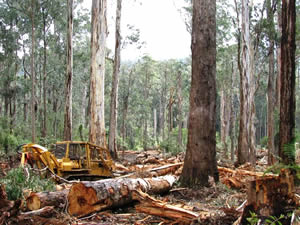
Australian Paper says its products are not sourced from high conservations value forests threatened by logging.
Shaun Scallan from Australian Paper says they withdrew because the audit process changed while it was underway.
“We pulled out because of a change in the definition of part of the standard late in the piece, which did not allow us enough time to then satisfy that changed definition,” he said.
.
.
Meanwhile the same Shaun Scallan of Australian Paper just the day prior on Monday 22 August 2011 posts his media release:
.
‘Australian Paper retains FSC Chain of Custody Certification’…?
by Shaun Scallan, Australian Paper, 20110822, ^http://australianpaper.com.au/media/2478/AP%20FSC%20audit%20release%20FINAL%20Aug%2022_2011.pdf, accessed 20110825
.
‘Australian Paper has successfully retained Forest Stewardship Council (FSC) Chain of Custody certification (FSC-C002059) in its latest audit. Auditor Rainforest Alliance confirmed that under the certification Australian Paper may continue to produce FSC-certified product based on sourcing of material from FSC-certified operations and recycled content, as allowed under the FSC rules for Mixed and Recycled product.
.
“We are pleased to have retained our FSC Chain of Custody certification,” Australian Paper CEO Mr Jim Henneberry said.
“Australian Paper has held Chain of Custody certification since 2006. However, we have decided to remove the Controlled Wood component from our certification at this time as there has been uncertainty around the interpretation of key elements of the standards.”
.
“Advice received by Rainforest Alliance from FSC International around the interpretation of the Standard was received after the physical audit had been completed. This left insufficient time for us to address and so we elected to withdraw Controlled Wood from our certification.” Mr Henneberry said.
.
Australian Paper remains committed to ensuring that fibre supplies come from internationally recognised, third party certified sources and also regards the Australian Forestry Standard and PEFC as benchmark certifications under this policy. The majority of wood supplied to Australian Paper is certified to the Australian Forestry Standard.
.
“We are also continuing to consult with a wide range of stakeholders as part of our Future Fibre Strategy review,” Mr Henneberry said.
“It is vital that we achieve the best balance between the environment, the health of regional communities and our ongoing competitiveness. We look forward to sharing outcomes from this review in due course.”
.
.
Meanwhile, we have the boss of Nippon Paper (the Japanese company that owns the misnomer ‘Australian Paper’) declaring Nippon Paper is going gang-busters to become a top global pulp and paper company…(at any cost?)
 ‘Since I was appointed president of Nippon Paper Group, Inc. in 2008, I have been pursuing “growth-oriented management.” This means exploring every possibility with a consistently positive stance, actively seizing opportunities, achieving the growth needed to become one of the top pulp and paper companies worldwide, as set out in the Group Vision 2015, and developing corporate value that meets the expectations of all stakeholders.’ ~ President of Nippon Paper Group, Yoshio Haga. [Source: ^http://www.np-g.com/e/about/president.html] ‘Since I was appointed president of Nippon Paper Group, Inc. in 2008, I have been pursuing “growth-oriented management.” This means exploring every possibility with a consistently positive stance, actively seizing opportunities, achieving the growth needed to become one of the top pulp and paper companies worldwide, as set out in the Group Vision 2015, and developing corporate value that meets the expectations of all stakeholders.’ ~ President of Nippon Paper Group, Yoshio Haga. [Source: ^http://www.np-g.com/e/about/president.html]
 . .
.
Meanwhile, the stated Charter of Nippon Paper Group includes:
.
‘6. Active involvement with environmental issues assures that…’
.
- ‘We shall promote afforestation projects, to create and make effective use of sustainable forest resources.’
- ‘We shall promote energy conservation, the use of wastepaper and other measures to effectively use resources that are limited in quantity.’
- ‘We shall manage and reduce all types of discharge and waste generated in the course of corporate activities.’
- ‘We shall research and develop manufacturing technologies, and products and services that are in harmony with the environment.’
.
[Source: ^http://www.np-g.com/e/about/charter.html#shead2]
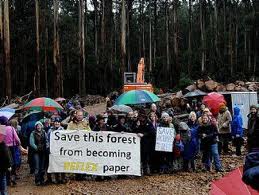
Editor: It is suspicious when a Japanese company is more than content to log and irrevocably destroy another country’s old growth forests, while Japan’s own old growth forests around Mt Fuji remain sacrosanct.
‘In spite of the abundant natural resources, logging is not commonly practiced in the forests of Japan. Japan Forests are venerated and protected since they provide essential soil cover and help in water conservation. All Species are encouraged to grow in the Forests in Japan , from the broad-leaved deciduous to the evergreen coniferous types. There are also many forests which grow near volcanic areas, destroyed and then rejuvenated every time an eruption occurs. The Aokigahara Forest at the base of Mount Fuji is one such forest. Locals as well as tourist camp, trek and hike through these dense forests of Japan to explore their unusual natural beauty.
‘Some Japan Forests are designated as Sacred Forests . These forests generally contain an ancient religious Shrine, usually worshiping the Shinto religion and are protected from trespassing and destruction. These forest shrines are still venerated as national treasures.
.
Some of the sacred forests in Japan are-
- The Forest of the Yahiko Jinja has many trees like the Cedar, Cypress and Oaks. The Shrine has a sacred Chinquapin tree as well.
- The Forest of Atsuta Jinja is an important Shinto Shrine, housing one the three important Shinto relics – the holy sword of Kusanagi-no-tsurugi. The forest has evergreens like the Japanese Camellia Sakaki, camphor trees, Ilex and Japanese Honeysuckle.
- The Forest of Kashima Jingu has over 800 species of trees like varieties of Cedar, Fir and Oak. The Kashima Jingu is an important shrine of the Kanto Area. The forest has been designated as a Wildlife Protection area for the rare birds in the region.
- The Forest of Shimogamo Jinja covers over 495 hectares and has many different species of deciduous trees like the Zelkova, the Elm and the Hackberry. The Shrine itself has 53 buildings which have been designated as National Heritage Architecture.
- The Forest of the Kirishima Jingu covers and area of 887 hectares. Located near the Mount Kirishima Volcano, the forest has been destroyed and then recovered for over 60 times.
- The Forest of the Kasuga Taisha is home to the beautiful podocarpus Nagi. The forest also contains many species of evergreens and shrubs. Trees like the Kasuga, the Andromeda and the Ichii also grow there. People from all over Japan visit the venerated shrine in the quarterly pilgrimages.‘
[Source: ^http://www.mapsofworld.com/japan/japan-tourism/forests-in-japan.html]
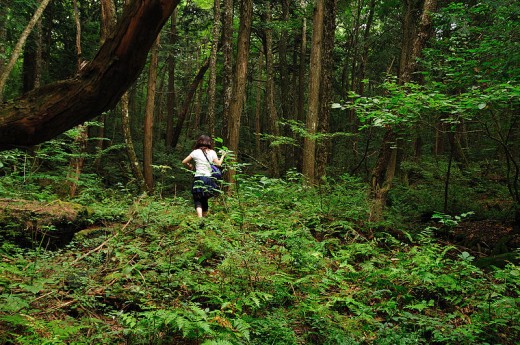 Japan’s sacred Aokigahara Forest Japan’s sacred Aokigahara Forest
.
Ethics question for Yoshio Haga (President of Nippon Paper Group):
What moral right do the Japanese have to consider their own native old growth Aokigahara Forest more sacred than Australia’s sacred native old growth forests such as those across East Gippland?
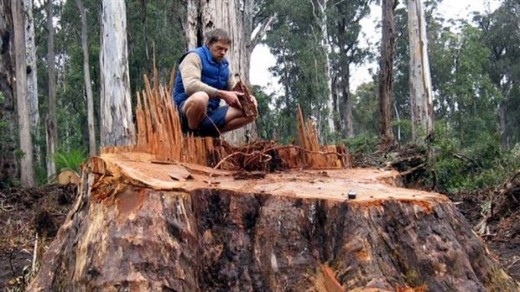 Stump of Brown Mountain’s sacred 600 year old Mountain Ash old growth tree.
It was logged by VicForests in November 2008 for Nippon Paper’s Reflex Paper. Stump of Brown Mountain’s sacred 600 year old Mountain Ash old growth tree.
It was logged by VicForests in November 2008 for Nippon Paper’s Reflex Paper.
.
.
In light of VicForests recent civil prosecution in the Victorian Supreme Court, Nippon Paper Group’s association with VicForests calls into question the reputation of Nippon Paper Group and its brand Reflex Paper:
.
‘VicForests has been stopped from harvesting certain coupes in the Brown Mountain forest in East Gippsland containing old growth forest
– habitat for rare and threatened species – until the completion of steps implementing the precautionary principle.’
.
.
.
‘Environment East Gippsland Inc v VicForests – The precautionary principle in action’
22 November 2010:
[Source: Blake Dawson (Lawyers), ‘Environment Matters’, 20111122, ^http://www.blakedawson.com/Templates/Publications/x_article_content_page.aspx?id=60457, accessed 20110825]
.
.
In Brief:.
- ‘The Victorian Supreme Court decision in Environment East Gippsland Inc v VicForests firmly embeds the approach to the precautionary principle laid down in Telstra Corporation Limited v Hornsby Shire Council (2006).’
- ‘The case makes it clear that the precautionary principle can be the subject of an enforceable obligation.’
- ‘The case also makes it clear that the precautionary principle applies both at the strategic and operational stages of a project or undertaking.’
- ‘The fact that VicForests complied with its forestry approvals was not enough to satisfy the Court that it had met its obligations with regard to the precautionary principle.’
.
‘In Environment East Gippsland Inc v VicForests [2010] VSC 335 conservation group Environment East Gippsland (EEG) won a landmark injunction against VicForests, a state-owned timber business with responsibility for commercial timber harvesting in Victoria’s state forests.
VicForests has been stopped from harvesting certain coupes in the Brown Mountain forest in East Gippsland containing old growth forest – habitat for rare and threatened species – until the completion of steps implementing the precautionary principle.
In this case, Justice Osborn of the Supreme Court of Victoria undertook a thorough analysis of the application of the precautionary principle in the context of a detailed legislative regime aimed at balancing biodiversity protection and commercial timber harvesting. The case embeds the approach to the precautionary principle laid down by Chief Justice Preston of the Land and Environment Court of New South Wales, in Telstra Corporation Limited v Hornsby Shire Council (2006) 67 NSWLR 256.’
.
The lead-up to the litigation
.
‘The Brown Mountain forests in Victoria’s East Gippsland contain old growth forests and provide habitat for rare and threatened species such as the Powerful Owl, the Spotted-tailed Quoll (mainland Australia’s largest marsupial carnivore) and the Long-footed Potoroo. However, these areas are also amongst the most productive timber harvesting forests in Victoria and play a crucial role in Victoria’s sustainable timber industry.
In 2006, the Victorian State Government committed to increasing the conservation parks and reserves within the broader Brown Mountain area. Nevertheless, in 2008 commercial logging in the Brown Mountain area began.
After numerous studies of the area indicated the presence of important threatened and rare species, EEG requested the Minister for Environment and Climate Change, Gavin Jennings, to make an interim conservation order to conserve critical habitat of the endangered Long-footed Potoroo, Spot-tailed Quoll, Sooty Owl, Powerful Owl and Orbost Spiny Crayfish at Brown Mountain. The Minister did not grant a conservation order, but instead increased the conservation area surrounding Brown Mountain.
Having failed to obtain undertakings from VicForests that it would not proceed to log the Brown Mountain coupes, EEG sought interlocutory injunctive relief. An interlocutory injunction restraining logging was granted by Justice Forrest on 14 September 2009 (see our article Environmental litigation heats up with some significant wins for public interest litigants in our 2 October 2010 edition of Environment Matters ), pending the outcome of the full proceedings before Justice Osborn in the Supreme Court of Victoria.’
.
The legislative regime
.
‘Logging of state forests in Victoria is regulated by a complex scheme of legislation, codes of practice, management plans and procedures, described by Osborn J as “labyrinthine”. The principal legislation includes the Forests Act 1958 (Vic) (Forests Act), Sustainable Forests (Timber) Act 2004 (Vic) (SFT Act), Flora and Fauna Guarantee Act 1988 (Vic) and Conservation, Forests and Lands Act 1987 (Vic).’
.
Responsibilities for timber harvesting and forestry management
.
‘VicForests is a state-owned corporation, established in 2004 to undertake the harvesting of timber in Victoria’s state forests. The Secretary to the Department of Sustainability and Environment (DSE) has overarching responsibility for managing state forests and timber harvesting within forests under the Forests Act.’
.
Legal challenge
.
‘EEG sought an injunction restraining VicForests from harvesting four coupes at Brown Mountain containing old growth forest. It also sought declarations that timber harvesting within the coupes by VicForests in accordance with the current forestry regime would be unlawful.
EEG argued that the current conservation measures for the Brown Mountain coupes did not meet the requirements of the regulatory system, which addresses the preservation of conservation values and in particular the protection of endangered species. EEG also argued that VicForests had failed to implement the precautionary principle.
VicForests took issue with EEG’s standing to sue. Further, it denied the presence of a number of endangered species and argued that the logging of the Brown Mountain coupes would take place under a legislative framework that adequately protects endangered species and would, therefore, be lawful. It also argued that it was DSE’s responsibility to stipulate any further requirements for habitat protection in accordance with the regulatory regime.’
.
EEG’s standing
.
‘Following the settled High Court authority that standing to bring such proceedings depends on the plaintiff’s “special interest” in the subject matter of the litigation (Australian Conservation Foundation v Commonwealth (2000) 200 CLR 591), Osborn J was satisfied that EEG had a relevant “special interest” because:
- EEG uses the coupes to a greater degree than the general public (for example, the group has a “Valley of the Giants Old Growth Forests Walk” through the affected coupes);
- EEG’s predecessor was involved in the consultative process for the formulation of the applicable forest management plan; and
- the government has previously recognised EEG’s status as a body representing this sector of the public interest.’
.
The precautionary principle [Ed: once again]
.
‘The VicForests case firmly embeds in Australian environmental jurisprudence the approach to the precautionary principle laid down by Chief Justice Preston of the Land and Environment Court of New South Wales, in Telstra Corporation Limited v Hornsby Shire Council (2006) 67 NSWLR 256 (Telstra). Justice Osborn’s decision in VicForests is the first Supreme Court application of the Telstra principles.
The precautionary principle is integrated throughout the Victorian forestry regime’s many instruments.
Following Preston CJ’s two-fold test in Telstra, Osborn J stressed that the precautionary principle is a test of common sense. There must be:
- a threat of serious or irreversible environmental damage; and
- scientific uncertainty as to the environmental damage.
Justice Osborn stated:
Once both of these conditions or thresholds are satisfied, a precautionary measure may be taken to avert the anticipated threat of environmental damage, but it should be proportionate … [The] degree of precaution appropriate will depend on the combined effect of the seriousness of the threat and the degree of uncertainty.
It is a “wherever practicable” test.
In practice, this meant that once the two-fold test was satisfied by EEG, VicForests had the onus of proving that the threat posed by logging the coupes did not exist or was negligible. Because it could not do this, the question then became:
- whether the threat was able to be addressed by adaptive management measures (in this case the requirement for surveys and management zone reviews); and
- whether the measure alleged to be required (here the permanent injunction against logging the coupes) was proportionate to the threat in issue.
Justice Osborn carefully examined the legislative regime and held that it is not intended that VicForests only apply the precautionary principle at the strategic planning stage:
VicForests is specifically required to apply it [the precautionary principle] having regard to the results of monitoring and research as they come to light during operations. … The requirements of the precautionary principle fall to be considered in the light of the whole of the evidence bearing on these matters as it now is and not as it was at the time VicForests completed planning.
Justice Osborn stressed, however, that the precautionary principle sits within a wider statutory regime that takes into account principles of sustainable development.
He held that unless VicForests complied with the requirements of the applicable Flora and Fauna Guarantee Act Statements and with conditions stated in the relevant allocation order (under the Forests Act) and the Timber Release Plan (under the SFT Act), logging at Brown Mountain would be unlawful.
This meant that VicForests could not rely on its current approvals to log the coupes because DSE had not, for example, changed zonings in the coupes to reflect the presence of threatened species. VicForests had an ongoing, active duty to apply the precautionary principle, which included responding to new information as it became available.
Importantly, Osborn J stressed that the precautionary principle can be the subject of an enforceable obligation.’
.
Outcome
.
‘Justice Osborn ordered that VicForests stop harvesting until various measures had been completed to respond to the detection of endangered species and to implement a precautionary approach with respect to their potential extinction. The required measures included:
- creating or amending special management zones, special protection zones and retained habitat areas to protect the Long-footed Potoroo, Greater Gliders and Yellow-bellied Gliders (as relevant);
- undertaking further surveys for the Giant Burrowing Frog, Large Brown Tree Frog and Spotted-tailed Quoll; and
- completing a current review of the Powerful Owl and Sooty Owl Management Areas,
to the satisfaction of the Director, Biodiversity Policy and Programs, DSE.
The difficulty for the Court in formulating its orders was that the power to act on the evidence of rare and endangered species and implement the required legislative and policy changes lies not with VicForests, against whom the injunction was sought, but with DSE.
Justice Osborn overcame this difficulty by stopping VicForests from logging until certain actions are undertaken, these actions being DSE responsibilities. VicForests had maintained throughout proceedings that it would comply with any changes to the regulatory regime made by DSE, and this was accepted by the Court.
.
Significance of the decision
.
This case firmly embeds the approach to the precautionary principle laid down by Chief Justice Preston in Telstra Corporation Limited v Hornsby Shire Council (2006) 67 NSWLR 256.
Justice Osborn’s decision makes it clear that:
- The precautionary principle can be the subject of an enforceable obligation.
- Parties having an obligation to apply the precautionary principle cannot demonstrate compliance with the principle solely through departmental approval of their actions or relevant approvals under the regulatory regime; the precautionary principle is an active obligation that applies throughout operations, requiring parties to respond to new information as it arises.
- The precautionary principle applies throughout all stages of operation, not just the strategic planning (or approvals) stage.
The decision has broader implications because:
- The precautionary principle is embedded in many other statutory regimes in Victoria and around Australia, apart from the Victorian legislative regime for forestry and the protection of endangered species. The decision has implications for any statutory regime in which the principle is enshrined.
- Although VicForest is a state-owned enterprise operating within a highly regulated environment, there is scope for the decision to be applied to other types of entities operating within industries where the precautionary principle is relevant.
Furthermore, a decision of the Supreme Court of Victoria has strong precedent value, and is likely to be adopted by the Supreme Courts of other States, and perhaps even higher courts or courts with federal jurisdiction.
.
Action points
.
Parties under an obligation to apply the precautionary principle need to be aware that:
- to implement the precautionary principle as per the principles laid down in Telstra, parties need to ask:
- is there a real threat of serious or irreversible damage to the environment?
- if yes, is it attended by a lack of full scientific certainty (in the sense of material uncertainty)?
- if yes, is the threat non-existent or negligible?
- if no, is the threat able to be addressed by adaptive management and is the measure alleged to be required proportionate to the threat in issue?
- the principle must be applied at both the strategic decision making stage of a project, and throughout the operational stage; and
- it may not be sufficient to simply obtain and comply with project approvals – parties need to proactively respond to new information as it arises throughout the operational stage.’
.
..
.
Further Reading:
.
[1] >Vicforests’ Ecological Genocide
.
[2] ‘Nippon buys Maryvale mill‘, by Ian McIlwraith, The Age newspaper, 20090217, ^http://www.theage.com.au/business/nippon-buys-maryvale-mill-20090216-89bu.html, accessed 20110826]
.
‘Paperlinx will take a $600 million hit on its half year results and the future of its Tasmanian operations is under review after last night unveiling the partial sale of its Australian papermaking business.
Japan’s Nippon Paper Group will buy most of Australian Paper, which includes the Maryvale pulp mill in Gippsland, for more than $700 million, including taking on attached debt and a three-year profit share agreement.
Money from the sale, expected to be completed in June, will go to reducing PaperlinX’s debt burden to about $340 million…’
[Editor: So Paperlinx was in debt to the Australian Tax Office by over a billion dollars? How can Australia’s pulp industry be profitable then?]
.
[3] Australian Paper Watch website (providing information about the logging of Victoria’s forests to make paper products such as Reflex by Nippon Paper and their ‘subsidiary’ Australian Paper), ^http://www.australianpaper.forests.org.au/
.
[4] Nippon Paper’s Maryvale Mill Upgrade, ^http://www.reflex.com.au/2008-Maryvale-Mill-Upgrade/
‘Australian Paper has a long history in the La Trobe Valley in Gippsland, Victoria, dating back to 1937 when established. Today, the Mill is Australia’s largest integrated pulp and paper operation. In response to global paper trends and changing consumer expectations for our products, Australian Paper (Nippon Paper subsidiary) embarked on a major upgrade of the Maryvale Pulp Mill in 2006 which was completed in December 2008. With an investment of $350 million, the upgrade significantly expanded the Mill’s production of bleached pulp capacity and delivered a range of safety, health and environmental benefits.’
.
[5] ‘Loggers, activists clash over forest‘, by Adam Morton, The Age newspaper, 20110817, August 17, 2011, ^http://www.theage.com.au/victoria/loggers-activists-clash-over-forest-20110816-1iwew.html
.
‘Conservationists have held up timber workers in a fiercely contested area of native forest on Melbourne’s fringe for nearly a month, chaining themselves to bulldozers and climbing trees scheduled for logging.
The protest, which has led to at least 10 arrests, is expected to reach a climax today as activists and local residents march into the logging coupe outside Toolangi in Victoria’s central highlands.
Protest organisers claim they have evidence the coupe is home to the endangered Leadbeaters Possum, which scientists say is under threat after Black Saturday bushfires wiped out up to half its habitat. But the Department of Sustainability and Environment says there has been no sign of live possums. Department spokeswoman Kim Payne said one tree in the coupe had hollows that showed evidence of possum use. That tree would be left standing, but the coupe did not meet the legal criteria of prime possum habitat and could otherwise be logged.
Sarah Rees, director of Healesville-based group My Environment, said it was cruel to think a possum could be protected by retaining a single tree while taking away the forest around it. She said logging was hurting central highlands communities.
.
”Tourism based on the state forest is far more important to the local economy than forestry and the two cannot co-exist,” she said.
The conflict over the Toolangi State Forest was the focus of a public meeting in the area late last week when logging opponents verbally clashed with forestry workers, who accused the activists of restraint of trade. One contractor said he had lost about $80,000 due to the protests.
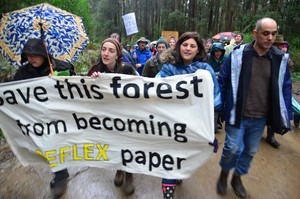
David Walsh, spokesman for state commercial timber agency VicForests, said the Toolangi protests had cost forest workers significant time. Only about a quarter of the 19-hectare coupe had been harvested. He said gates raised to ensure public safety had been damaged. ”VicForests believes these are legal harvesting operations which comply with the detailed legislative framework governing native timber harvesting in Victoria,” he said.‘
.
Editor: The legal doctrine of ‘restraint of trade’ sought to be applied in the commercial exploitation and destruction of old growth forests, is an invalid excuse. It is a contemptible euphemism for a ‘right to rape’ old growth ecology that is being contrived by commercial lawyers profiting from the exploiters ~ a case of the morally bankrupt collaborating with the damned.
[6] Ethical Paper website, ^http://www.ethicalpaper.com.au/
.
[7] My Environment website, ^http://www.myenvironment.net.au/
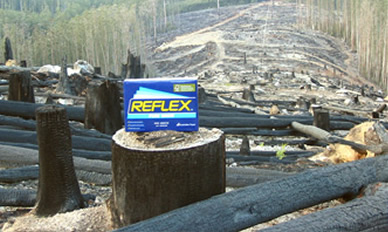
.
– end of article –
Tags: Aokigahara Forest, Atsuta Jinja, Australian Forestry Standard, Australian Paper, Chain of Custody certification, deforestation, East Gippsland, EEG, endangered species habitat, Environment East Gippsland, Environment East Gippsland Inc v VicForests, Flora and Fauna Guarantee Act, Forest Stewardship Council, Forestry Standard Certification, FSC, FSC audit process, FSC Chain of Custody Certification, FSC International, FSC-C002059, Future Fibre Strategy, Giant Burrowing Frog, Greater Glider, Greenwash Tick, Kashima Jingu, Kasuga Taisha, Kirishima Jingu, Large Brown Tree Frog, Leadbeaters Possum, Logging, Long-footed Potoroo, Maryvale Pulp Mil, My Environment, Nippon Paper Group, PEFC, Powerful Owl, precautionary principle, pulp and paper, Rainforest Alliance, Reflex Paper, restraint of trade, right to rape, sacred forest, Shimogamo Jinja, Shinto religion, Sooty Owl, The Wilderness Society, Timber Release Plan, Toolangi State Forest, TWS, VicForests, Yahiko Jinja, Yellow-bellied Glider
Posted in Gippsland (AU), Owls, Potoroos, Quolls, Reptiles, Threats from Deforestation | No Comments »
Add this post to Del.icio.us - Digg
Thursday, August 25th, 2011
The following article was initially published by The Wilderness Society (NSW) on its website 20110729. Reproduced with permission from The Wilderness Society (NSW):
 A dying river near Broken Hill, NSW (not so long ago) A dying river near Broken Hill, NSW (not so long ago)
is visited by Chris Daley, the Wilderness Society rivers campaigner.
Photo by Dean Sewell
.
Despite common perceptions, the problems facing the Murray-Darling Basin are not confined to rural communities, and their social implications are extensive.
Adelaide, for example, relies on the Murray-Darling to provide around 55% of its drinking water. In fact, more than four million people depend on the Basin for water. But the future of the Murray-Darling and its communities are under threat from over-extraction of water, salinity and climate change. The Basin supports diverse communities that have grown up on the river, and who consider it to be central to their way of life. Locals see the river as extremely important from a social point of view, as Barney Stephens from the Darling River Action Group pointed out.
“The lakes and the Darling River and the Anabranch are basically Broken Hill’s recreation. People think of recreation as something that’s maybe not essential, but when you look at an isolated town like Broken Hill, if you take the lakes away and the rivers away it’s like taking the beaches away from Sydney.”
Dr. James Pittock, Programme Leader of Australian and United States Climate, Energy and Water at the US Studies Centre, Australian National University, agrees that returning water to the Basin is socially and economically important.
.
Multiple Benefits
.
“The water in the Murray-Darling Basin provides lots of different benefits for people, and many of those benefits are gained from leaving water in the river, in terms of providing habitat for fish right through to the Lower Lakes and Coorong near the sea where [there are] massive fishing industries, both commercial and recreational”, said Pittock.
Both men also point to the cultural significance of the river to aboriginal people that have lived by the river for thousands of years. “Most of them [in the Broken Hill area] were Paakantji, which means ‘river people’, and the river is just essential to them,” said Stephens.
While irrigators have argued that the Basin Plan has the potential to damage rural communities, Dr. James Pittock says the social consequences of not returning health to the river will be far worse.
“If this Basin Plan isn’t implemented well, that is if the reform isn’t substantial in quickly reallocating a lot of water from agriculture to the environment, we risk another crisis in a few years time.”
.
Best chance in a generation
.
“We will be back to this public dispute over water allocation…and eventually industry will be forced to cut back to sustainable levels. Now the question for the industry is, do you want to do that now, and do it with some certainty so that rural communities can get on with planning a more sustainable future? Or alternatively, if this opportunity for reform is fudged in some political compromise, do you really want to live with the uncertainty of repeating the exercise every five to ten years when the next drought hits?”
Right now, the Government and the Murray-Darling Basin Authority (MDBA) have a responsibility to rectify these problems once and for all in the development of the Murray-Darling Basin Plan. To do so, they must commit to buying back 7,600 gigalitres of water to be returned to the system. This was the scenario identified in the MDBA’s Guide to the proposed Basin Plan as carrying the least risk of irreversible damage to the river system.
The Wilderness Society is urging the Australian Government to spend the $10 billion of taxpayers’ money allocated to save the Basin wisely, or give the Australian public their money back. Responsible and scientifically based action to ensure the sustainability of the Basin will help to build stronger, more diverse rural communities.
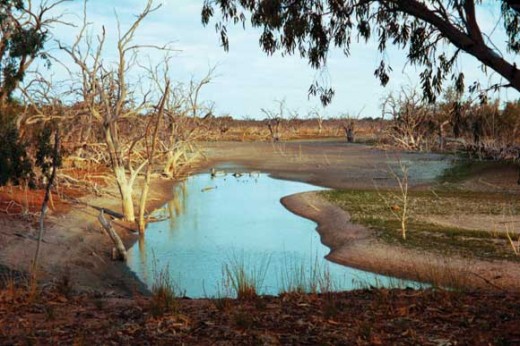 Menindee Lakes —inlet to Lake Cawndilla during drought in 2003 Menindee Lakes —inlet to Lake Cawndilla during drought in 2003
(MDBC Annual Report 2003-04, Photo: L. Palmer)
.
.
.
Further Reading:
.
[1] Jamie Pittock BSc. Hons (Monash), PhD (ANU) is ‘Director of International Programs for the UNESCO Chair in Water Economics and Transboundary Water Governance, Program Leader, Australia and United States – Climate, Energy and Water, US Studies Centre and ANU Water Initiative. Jamie Pittock is Director of International Programs for the UNESCO Chair in Water Economics and Transboundary Water Governance. His current work includes developing research programs that link Australian and southern African expertise to improve management of river basins, green water and agriculture. He is also Program Leader for the Australia and United States – Climate, Energy and Water project of the US Studies Centre and ANU Water Initiative. [Read More].
[2] Darling River Action Group, ^http://www.d-r-a-g.org.au/
[3] Paakantji, ^http://www.curriculumsupport.education.nsw.gov.au/secondary/languages/languages/aboriginal/campfire/stories/paakantji/paakantji_stories.htm
[4] The Wilderness Society (NSW), River Protection Campaigns, ^http://www.wilderness.org.au/campaigns/river-protection
[5] ‘Living Murray, Dying Darling – the year our fish died and Broken Hill cried,’ speech by Joe Flynn, Managing Director, Australian Inland at the Murray Darling Association Annual Conference in Renmark, South Australia 20040902. [Read More]
[6] ‘Great Darling Anabranch to receive much-needed environmental flows‘, Murray-Darling Basin Authority (MDBA), 20100909, ^http://www.mdba.gov.au/media_centre/media_releases/great-darling-anabranch-to-receive-much-needed-environmental-flows, [Read More]
.
– end of article –
Tags: Anabranch, Darling River, Darling River Action Group, Energy and Water, MDBA, Menindee Lakes, Murray-Darling, Murray-Darling Basin Authority, Paakantji, The Wilderness Society, TWS
Posted in Murray Darling (AU), Threats from Farming | No Comments »
Add this post to Del.icio.us - Digg
Thursday, August 25th, 2011
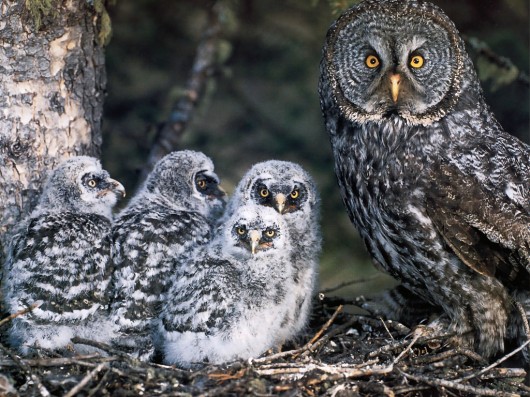 The Great Grey Owl of Lapland (Strix nebulosa) – the largest owl in existence
(click to enlarge) The Great Grey Owl of Lapland (Strix nebulosa) – the largest owl in existence
(click to enlarge)
.
‘A little knowledge is a dangerous thing‘ is a wise old proverb meaning that a small amount of knowledge can mislead people into thinking that they are more expert than they really are.
The phrase is considered originally derived from English politician and philosopher, Francis Bacon, in his literary work ‘The Essays: Of Atheism‘ of 1601, as follows:
.
“A little philosophy inclineth man’s mind to atheism; but depth in philosophy bringeth men’s minds about to religion.” [1]
.
It may generally apply quite aptly across the human species. Homo sapiens sapiens is the most intelligent species on the planet. Yet given our legacy thus far, are we really much more intelligent than any other species that exists simply to breed and perpetuate its species?
Our intelligence has enabled us to successfully breed not just for survival, but to colonise the planet like no other. Yet our intelligence can only be a little more intelligent than other species, since our breeding and colonisation has grown to such an extent that it has driven other species to extinction and has destroyed much of the planet upon which we depend. While other species have a symbiotic relationship with their environment, the extent of ecological destruction that humanity has caused and continues to cause to our host planet makes us Earth’s Pathogen. A pathogen is an agent causing disease or illness to its host, such as an organism or infectious particle capable of producing a disease in another organism. Human breeding and colonisation is extreme to the extent that it is approaching 7 billion. As we exponentially breed, colonise and destroy, we destroy our host planet.
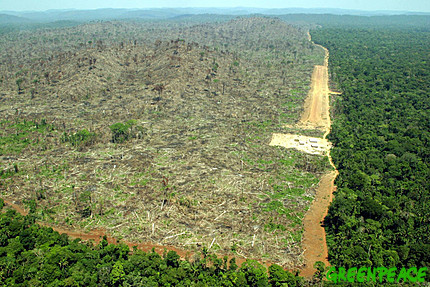
Speaking of religion, the demise and extinction of the Rapa Nui civilization on the remote Easter Island in the Pacific Ocean has become a metaphor for the self-destruction of humanity. One theory for the collapse of the Rapa Nui culture is that the Ancestor Cult that respected the dead drove the building of large stone statues (moai) to represent deified ancestors. It was believed that the living had a symbiotic relationship with the dead where the dead provided everything that the living needed (health, fertility of land and animals, fortune etc.) and the living through offerings provided the dead with a better place in the spirit world. The island’s trees were killed and used to help move these massive moai into desired position, but over time, as more moai were erected, the island’s trees were eliminated. Absolute deforestation led to the collapse of the island’s ecosystem and food supply and so to the demise of the Rapa Nui.
A second theory is that by Hunt and Lipo (2006) who found no evidence of human deforestation, or of human habitation prior to 1200. Instead, they suggest that the collapse of island society was due to the introduction of Polynesian Rats that arrived in the boats of early settlers. They hypothesize that rat population spiked at around 20 million individuals, and that these rats quickly consumed all the seeds of the native palms, leading to the collapse of the island food supply. [2]
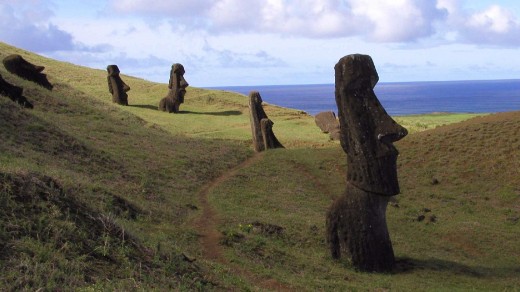 The Moai of Easter Island,
the living faces of worshipped ancestors of the Rapa Nui people
(click to enlarge) The Moai of Easter Island,
the living faces of worshipped ancestors of the Rapa Nui people
(click to enlarge)
.
.
‘Homo sapiens – time for a new name?
The following article is directly sourced from a transcript by Julian Cribb on the ABC Radio Science Show programme, which was aired 20110820 [3]
.
“It is high time the human race had a new name. The old one, Homo sapiens – wise or thinking man – has been around since 1758, and is no longer a fitting description for the creature we have become. When the Swedish father of taxonomy, Carl Linnaeus, first bestowed iti, humans no doubt seemed wise when compared with what scientists of the day knew about both people and other animals. We have since learned our behaviour is not quite as intelligent as we like to imagine, while some other animals are rather smart. In short, ours is a name which is both inaccurate and which promotes a dangerous self-delusion.
In a letter to Nature I am proposing there should be a worldwide discussion about the formal reclassification of humanity, involving both scientists and the public. The new name should reflect more truthfully the attributes and characteristics of the modern 21st century human, which are markedly different from those of 18th century ‘man’.
Consider the following: Humans are presently engaged in the greatest act of extermination of other species by a single species, probably since life on Earth began. We are destroying an estimated 30,000 species a year, a scale comparable to the greatest extinction catastrophes of the geological past.ii We currently contaminate the atmosphere with 30 billion tonnes of carbon equivalent every year.iii This risks an episode of accelerated planetary warming reaching 4-5 degrees by the end of this century and 8 degrees thereafter, a level which would severely disrupt food production.iv Estimates for the ultimate losses from 8of warming range from 50 to 90% of humanity.v
We have manufactured around 83,000 synthetic chemicalsvi, many of them toxic at some level, and some of which we inhale, ingest in food or water or absorb through the skin every day of our lives. A US study found newborn babies in that country are typically contaminated by around 200 industrial chemicals, including pesticides, dioxins and flame retardants.vii These chemicals are now found all over the planet, and we are adding hundreds of new ones, of unknown risk, every year. Yet we wonder why more people now die of cancer.
Every year we also release around 121 million tonnes of nitrogen, 10 million tonnes of phosphorus and 10 billion tonnes of CO2 into our rivers, lakes and oceans, many times the amounts recirculated by the Earth naturally. This is causing the collapse of marine and aquatic ecosystems, disrupting food chains and causing ‘dead zones’. More than 400 of these lifeless areas have been discovered in recent times.viii
We are presently losing about 1% of the world’s farming and grazing land every year. This has worsened steadily in the last 30 years, confronting us with the challenge of doubling food production in coming decades off a small fraction of today’s area. At the same time we waste a third of the world’s food.ix
Current freshwater demand from agriculture, cities and energy use will more than double by mid century, while resources in most countries – especially of groundwater – are drying up or becoming so polluted they are unusable.x
We passed peak fish in 2004xi, peak oil in 2006xii, and will encounter growing scarcities of other primary resources, including mineral nutrients, in coming decades. Yet demand for all resources, including food, minerals, energy and water, will more than double, especially in Asia.
Humanity spends $1.6 trillion a year on new weaponsxiii, but only $50 billion a year on better ways to produce food. Despite progress in arms reduction, the world still has around 20,000 nuclear warheads and at least 19 countries now have access to them or to the technology to make them.xiv
Finally, we are in the process of destroying a great many things which are real – soil, water, energy, resources, other species, our health – for the sake of a commodity that mostly exists in our imagination: money. While money has its uses as a medium for exchange, humanity is increasingly engaged in mass self-delusion as to what constitutes real wealth, as is quite clear from the current financial crisis.
All of these things carry the risk of catastrophic change to the Earth’s systems, making it difficult to justify our official sub-species name of Homo sapiens sapiens, or wise wise man. This not only looks like conceit, but sends a dangerous signal about our ability to manage what we have unleashed. A creature unable to control its own demands cannot be said to merit the descriptor ‘wise’. A creature which takes little account of the growing risks it runs through its behaviour can hardly be rated ‘thoughtful’.
The provisions of the International Code on Zoological Nomenclature provide for the re-naming of species in cases where scientific understanding of the species changes, or where it is necessary to correct an earlier error. I argue that both those situations now apply.
This is not just an issue for science; it concerns everybody. There needs to be worldwide public discussion about what is an appropriate name for our species, in the light of our present behaviour and attributes. Here are some names suggested by eminent Australian scientists. Marine scientist and author, Charlie Veron, suggests Homo finalis. Desert ecologist, Mark Stafford-Smith, proposes Homo quondam et futures – the once and future human. Spatial ecologist, Hugh Possingham, likes Homo nesciens – ignorant man. And atmospheric scientist, Barrie Pittock, suggests Homo sui deludens – self-deluding man.
Down the track we should not rule out an eventual return to the name Homo sapiens, provided we can demonstrate that we have earned it – and it is not mere flatulence, conceit or self-delusion. The wisdom to understand our real impact on the Earth and all life is the one we most need at this point in our history, in order to limit it. Now is the time humans get to earn, or lose forever, the title sapiens.”
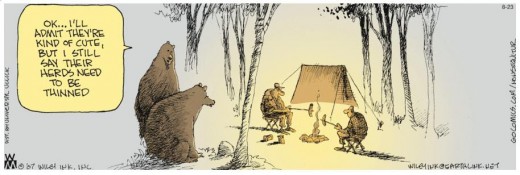 (Source: Non Sequitur – by Wiley Miller, ^http://www.gocomics.com/nonsequitur/2011/08/23) (Source: Non Sequitur – by Wiley Miller, ^http://www.gocomics.com/nonsequitur/2011/08/23)
.
.
Editor: Globally, a material difference between Humanity and other species is that we are more intelligent at doing what other species naturally do – colonising for our own self-interest. We are Homo colonus ventosa (the conceited coloniser), or simply Homo ego ruina (self-destructive Man).
If we accept that at our current stage of evolution we have a little more knowledge than other species; and that our legacy has proven thus far to be dangerous to us, other species and to the planet, then we would be wise to seek deeper knowledge of our circumstance, of our place and of other species and the planet. The test for Humanity now is to ask what would the wise do and not do? A first step in advancing our species is to recognise that we have become Earth’s Pathogen. the second step is to recognise that we don’t know the true extent of the damage we are causing to the planet and so in the face of such uncertainty, we are wise to adopt a precautionary approach. The Precautionary Principle states: ‘When an activity raises threats of harm to human health or the environment, precautionary measures should be taken even if some cause and effect relationships are not fully established scientifically. In this context the proponent of an activity, rather than the public, should bear the burden of proof. The process of applying the Precautionary Principle must be open, informed and democratic and must include potentially affected parties. It must also involve an examination of the full range of alternatives, including no action.’ [4]
.
‘We abuse land because we regard it as a commodity belonging to us. When we see land as a community to which we belong, we may begin to use it with love and respect.’
~Aldo Leopold, A Sand County Almanac (1949).
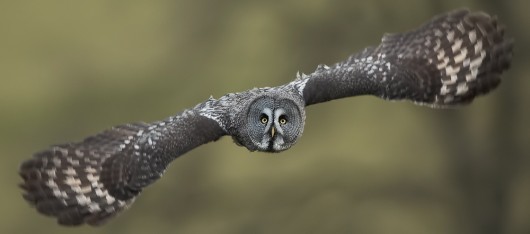 The Great Grey Owl in flight
(click to enlarge) The Great Grey Owl in flight
(click to enlarge)
.
.
References:
.
[1] ^ http://www.phrases.org.uk/meanings/a-little-knowledge-is-a-dangerous-thing.html
[2] Hunt, T. L.; Lipo, CP (2006). “Late Colonization of Easter Island”. Science 311 (5767): 1603
[3] ‘ Homo sapiens – time for a new name?‘, Julian Cribb, ^ http://www.abc.net.au/rn/scienceshow/stories/2011/3294576.htm, accessed 20110825
[4] Nancy Myers, 2004, ‘The Rise of the Precautionary Principle – A Social Movement Gathers Strength’ in  , September 2004, Vol. 25, No.9, http://multinationalmonitor.org/mm2004/09012004/september04corp1.html [> Read More]
.
– end of article –
Tags: a little knowledge is a dangerous thing, Aldo Leopold, Earth's Pathogen, Easter Island metaphor, Great Grey Owl, Homo sapiens sapiens, human pathogen, Rapa Nui
Posted in Owls, Ph05 Earth's Pathogen, Threats from Deforestation, Threats from Overpopulation | No Comments »
Add this post to Del.icio.us - Digg
Friday, August 19th, 2011
(The following article was initially posted on CanDoBetter.net by Tigerquoll on 20090426. It has since been modified.)
.
 VicForests’ neo-colonial practice of logging old growth East Gippsland forests, justifies such culling by claiming compliance with Australia’s wood production Standard AS 4708-2007. But this standard is Mein Kampf for ecological genocide of East Gippsland Forests. VicForests’ neo-colonial practice of logging old growth East Gippsland forests, justifies such culling by claiming compliance with Australia’s wood production Standard AS 4708-2007. But this standard is Mein Kampf for ecological genocide of East Gippsland Forests.
Have a read: http://www.forestrystandard.org.au/files/Standards/4708.pdf [Read the Standard]
Under this official Australian Standard that sees only the wood for the trees, it includes two criteria that serve to deliver propaganda spin respect for forest ecology. One must recognise these criteria accompanying Criterion 4—Forest management shall maintain the productive capacity of forests. Need I say more?
Forestry Propaganda Criterion #3 for instance, requires forest management to ‘protect and maintain the biological diversity of forests’. Wonderful wholesome, noble and holistic rumblings about this one – but gullibles wake! VicForests <em>Mein Kampf</em> hides the ‘ chainsaw-speak‘ in the detail:
* ‘Small-scale clearing is permitted up to a limit of 40 hectares on a single forest management unit’. ‘Conservation of threatened (including vulnerable, rare or endangered) species and ecological communities requires the forest manager to minimise adverse impacts by ensuring he/she takes into account of known information and relevant specialist advice‘. (Makes Fiji look like a democracy!)
Forestry Propaganda Criterion 5 requires forest management to maintain forest ecosystem health and vitality, yet is so vague as to allow forest ‘practices’ only to ensure that damage stays “within tolerable levels”. Does this mean one tree per hectare can be left standing or may be two?
.
Then there’s Clause 4.5.3:
‘Forest managers managing native forests shall use fire and other disturbance regimes to maintain and enhance forest ecosystem health where appropriate to the forest type or scale.’ [p.25]
.
…that is, burn and disturb native forests at will, because we argue that doing so enhances forest ecosystem health. Whoops! The wind picked up and the forest is gone; still we complied with AS 4708-2007!
Such contemptible logic would argue that a bushfire raging through a town can to it good, because eventually the town is rebuilt and the people eventually return, look at Narbethong!
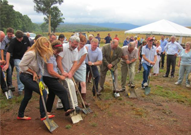
.
.
The Ferguson Tree – lest we forget
.
“The tallest tree ever properly measured was a Eucalyptus tree and was 436 feet tall. It was measured by William Ferguson on the 21st of February in 1872. Alarmingly the crown was broken off when the tree was still 1 meter thick, leading to claims that it once was up to five-hundred feet tall in one point in its lifetime.”
The length was a staggering (if true) 133 metres (436 feet) with its crown (the tree’s top) broken off!! The stump’s diameter five feet off the ground was 5.5m (18 feet) and at its broken top its diameter was still 1 metre. It is estimated that had this tree actually still been intact it would have approached 152m (500 feet) in height. The surveyor also noted numerous fallen trees in the same area over 106m (350feet) in height.
It would have been a Mountain Ash or Eucalyptus regnans. Sorry, no photo available. The legend remains only in text.
[Source: ^http://jtpredwoods12345.blogspot.com/]
.
.
‘VicForests accused of felling old-growth mountain ash’
.
[Source: Adam Morton, 20100629, The Age newspaper, ^http://www.theage.com.au/victoria/vicforests-accused-of-felling-oldgrowth-mountain-ash-20100628-zf5o.html]
.
‘The Victorian government’s forestry arm will face a legal challenge over claims it illegally logged old-growth forest and increased the risk to a threatened species.
Environmental groups accuse VicForests of felling dozens of pre-1900 ash eucalypts, breaching the Central Highlands Forest Management Plan. An impending legal case will also claim the timber agency failed to protect habitats necessary for the survival of Victoria’s threatened faunal emblem, Leadbeater’s possum.
Ecologist Jacques Cop, from consultants Acacia Environmental Group, said a survey of just one coupe near Toolangi found 31 pre-1900 ash eucalypts had been logged. Five stumps were more three metres across.
”These are trees that are 200 or 300 years old,” he said.
Mr Cop said the area should also have been protected as a Leadbeater’s possum habitat as it met the threshold of having at least 12 hollowed trees within three hectares. He said neither the state Department of Sustainability and Environment nor VicForests carried out ground surveys to check if ecological requirements were being met. Sarah Rees, president of local group My Environment, said the situation was an emergency.
’31 pre-1900 ash eucalypts had been logged’
.
“If this doesn’t stop we’re going to lose the last viable habitat for a range of different species, but Leadbeater’s possum carries the strongest case for legal protection“, she said.
The state government said it took the allegations “extremely seriously“.
Spokesman Michael Sinclair said VicForests would investigate the alleged breaches and report to the Department of Sustainability and Environment. VicForests spokesman David Walsh said the agency carried out detail planning before harvesting to ensure it acted within the law and had offered to meet local residents to better understand their concerns.
“No old-growth forest is harvested by VicForests in Victoria’s central highlands region”, he said.
The legal case, being prepared on behalf of a group called the Flora and Fauna Research Collective, comes amid community concern about the scale of logging in the central highlands after the Black Saturday bushfires.
The Wilderness Society said that evidence supporting the latest claims showed illegal logging of native forests was rife under the state government’s watch.
A separate allegation of illegal logging at Brown Mountain, in east Gippsland, is the subject of a pending Supreme Court judgment.
“Premier Brumby must act now to end VicForests’ woodchip rampage in Victoria’s magnificent native forests“, said Wilderness Society spokesman Luke Chamberlain.
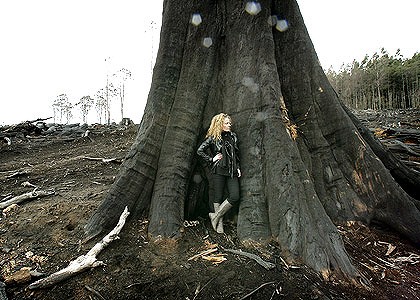
Sarah Rees at the base of an ancient mountain ash spared the chainsaw but killed during a clean-up fire near Toolangi.
She says the present situation is an emergency.
Photo: John Woudstra
.
.
 VicForests motto reads: “Victorian Timber: beautiful, natural, functional” VicForests motto reads: “Victorian Timber: beautiful, natural, functional”
[SOURCE: http://www.vicforests.com.au/]
.
..in lay terms, this means kill beautiful natural specimens – they make the finest woodchips for reliable REFLEX office paper.
.
.
VICFORESTS: “VicForests employs over 140 staff across 10 Victorian sites located in Melbourne, Healesville and regional areas of Central Highlands and East Gippsland.
We have a variety of exciting career opportunities available – our Foresters specialise in tactical and operational planning, roading, harvesting and contract management, silviculture and native forest regeneration.
Other career paths include customer management, resource and business analysts, safety and risk, operational audit, forest scientists and product delivery.”
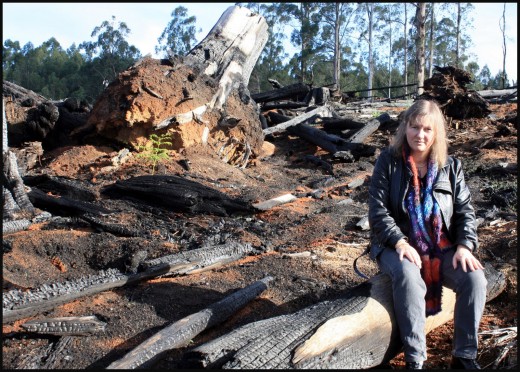
VICFORESTS: “We also employ staff in non-forestry roles including IT, HR, communications, finance, administration and customer service. A significant proportion of our staff and contractors are also involved with fire-fighting efforts each year.
VicForests is focused on investing in its employees through training, development, and providing career opportunities.”

VICFORESTS: “We look for dynamic people who have a strong desire to be part of an organisation that strives to achieve success through implementing excellent and innovative business and timber industry practices for our customers and stakeholders.
Contributing to the timber industry is something that VicForests and its staff are proud of.”
.
[Source: ^http://vicforests.logic1.com.au/employment.htm, accessed 20110819]
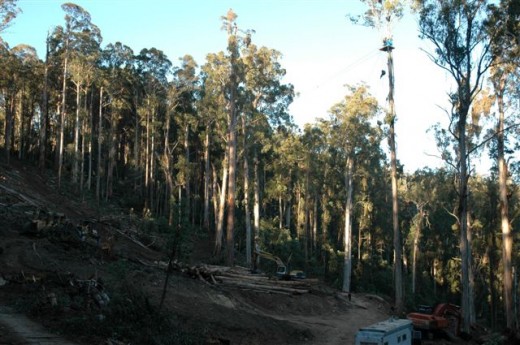 Vicforests’ coup at Stoney Creek
East Gippsland 2009 Vicforests’ coup at Stoney Creek
East Gippsland 2009
.
.
‘VicForests’ 2009 Annual Report reveals $5.1 million loss’
.
‘VicForests’ 2009 Annual Report has once again revealed that the logging agency continues to waste taxpayer millions of dollars sending our forests to the woodchip mills. The report shows that VicForests has posted a loss this year of $5.1 million. This is on top of last year posting a tiny profit after receiving a $5 million lifeline from government, and a loss the previous year.
 Woodchip train makes its way to Midways, Geelong (2009) for as little as $2.50 per tonne.
Photo: Wilderness Society Collection
Woodchip train makes its way to Midways, Geelong (2009) for as little as $2.50 per tonne.
Photo: Wilderness Society Collection
.
‘Whilst VicForests squanders Victorian taxpayer’s hard earned money, woodchipping and paper companies continue to post handsome profits. Whilst we don’t yet know how much they will make for 2009, South East Fibre Exports, a wholly owned subsidiary of Japanese paper giant, Nippon Paper, last year made over $10 million profit. They woodchipped approximately half a million tonnes of Victoria’s native forests, and this year paid as little as $2.50 per tonne for them.
Another giant company, Australian Paper, which makes Reflex papers, is VicForests’ largest single customer and was recently purchased for around $700 million by Nippon Paper. The $5.1 million loss is on top of an extra $1.3 million handout for bushfire recovery and does not include the massive $29 million royalty that it has failed to hand over to the state government who, along with the Victorian public, own these forests.’
.
[Source: ^http://www.wilderness.org.au/campaigns/forests/vicforests-2009-annual-report-reveals-5.1-million-loss]
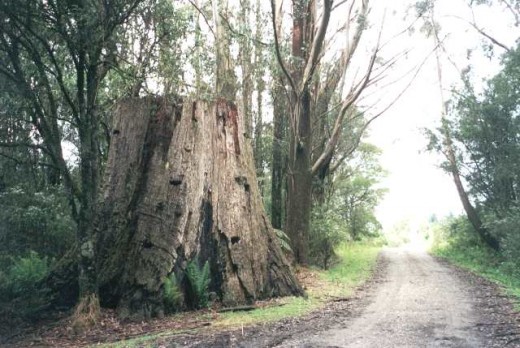 A tombstone of the once impenetrable forest.
A Mountain Ash stump alongside an old forestry track in Balnook, Gippsland.
Note the notches cut in the trunk for standing planks to cut the tree down by axe!
A tombstone of the once impenetrable forest.
A Mountain Ash stump alongside an old forestry track in Balnook, Gippsland.
Note the notches cut in the trunk for standing planks to cut the tree down by axe!
.
.
Reflex Office Paper
‘Paperlinx’s giant Maryvale mill located in Victoria’s Central Highlands is the largest pulp and paper making complex in Australia, consuming 475,000 cubic metres of eucalyptus forest per annum (RFA, 1998).
‘In July 2006, the Maryvale Mill received Forest Stewardship Council (FSC) Chain of Custody Certification for A4 Reflex products manufactured on its Number 3 and Number 5 Paper Machines. Paperlinx has been proudly promoting its environmental credentials ever since (as well as before).
Paperlinx is Australia’s only office paper producer. Its flagship product REFLEX copypaper is 100 per cent virgin native forest. Woodchips to make the paper are sourced from areas including rainforest, old growth forest, endangered species habitat and Melbourne’s largest water source, the Thompson Dam catchment area. Woodchips are also sourced from the Strzelecki Rainforest Reserve, an area that was promised protection by the state government due to its high conservation value.
These areas can be visited and viewed first hand, or determined by satelite image maps which show different forest types (such as rainforest as compared to woodlands) and where logging is occuring. The fact that Paperlinx gained FSC accreditation has raised concerns amoung environment groups who have been campaigning for the protection of these areas for over a decade.
Reflex Recycled Paper
Paperlinx has recently released a brand of paper wrapped in green packaging labelled Recycled. Fifty percent of REFLEX Recycled paper is made from pre-consumer waste (printers’ offcuts), but no genuine post-consumer (eg kerbside collected) recycled papers. The other fifty percent is from the same virgin native forest as stated above.
According to The Wilderness Society Paperlinx has the resources and technology to make use of alternative sources such as plantations and recycled paper, but doesn’t do so as it receives state-owned native forest logs for a significantly lower cost than plantation logs.
Due to the lack of accurate information reaching the public, an alliance of Australia’s peak environment groups including The Wilderness Society, Environment Victoria, Friends of the Earth and the Australian Conservation Foundation released a flier in 2004 urging people to boycott REFLEX paper and listing alternatives.
THE ALTERNATIVE
There is no 100 per cent recycled office paper manufactured in Australia. Brands made overseas that are available in Australia include Evolve, Canon 100 and Fuji Xerox Recycled Supreme.’
[Source: ‘Reflex Office Paper‘, Greenwash .org ^http://www.greenwashreport.org/node/41 ]
.
‘Always rely on Reflex to woodchip old growth‘
  Scott Gentle from the Victorian Forest Contractors Association
questions the logic of the Yarra Ranges council’s decision to boycott Reflex paper products.
[Source: ^http://free-press-leader.whereilive.com.au/news/story/paper-ban-anger/] Scott Gentle from the Victorian Forest Contractors Association
questions the logic of the Yarra Ranges council’s decision to boycott Reflex paper products.
[Source: ^http://free-press-leader.whereilive.com.au/news/story/paper-ban-anger/]
.
.
Further Reading:
.
[1] ‘Brown Mountain Rape’, ^http://candobetter.net/node/1005
[2] Ethical Paper, ^http://www.ethicalpaper.com.au/
[3] Save Sylvia Creek Toolangi, ^http://www.myenvironment.net.au/index.php/me/Community/SAVE-Sylvia-Creek-Toolangi
[4] Brown Mountain – final court orders, ^http://www.eastgippsland.net.au/?q=campaigns/brown_mountain/whats_new
[5] Reflex Office Paper, ^http://www.greenwashreport.org/node/41
[6] Victorian Supreme Court Decision: ‘Environment East Gippsland Inc v VicForests [2010] VSC 335 (11 August 2010)’, ^http://www.austlii.edu.au/au/cases/vic/VSC/2010/335.html
.
.
– end of article –
Tags: Acacia Environmental Group, Australian Paper, Brown Mountain, chainsaw-speak, East Gippsland logging, ecological genocide, Ferguson Tree, Forestry Standard 4708, Forestry Standard Certification, Gippsland Giants, illegal logging, Leadbeater’s possum, Logging, Nippon Paper Group, Reflex Paper, Toolangi, VicForests
Posted in Gippsland (AU), Possums and Gliders, Threats from Deforestation | No Comments »
Add this post to Del.icio.us - Digg
|
|
 The magnificent African Bush Elephant bull (male) walking tall in its native savannah homeland
The magnificent African Bush Elephant bull (male) walking tall in its native savannah homeland
 Tool of the Willing
(for just one day hire, …’our troubles there would be over very quickly’.)
~ borrowed from Colonel Walter E. Kurtz.
Tool of the Willing
(for just one day hire, …’our troubles there would be over very quickly’.)
~ borrowed from Colonel Walter E. Kurtz.
 This elephant tusk (ivory) carving (photo) is a gift from China presented to the United Nations in 1974.
It depicts the Chengtu-Kunming railway, which was opened to traffic in 1970.
The sculpture was carved from eight elephant tusks. In elephant terms, four mature bull elephants were killed for this elaborate trinket.
This elephant tusk (ivory) carving (photo) is a gift from China presented to the United Nations in 1974.
It depicts the Chengtu-Kunming railway, which was opened to traffic in 1970.
The sculpture was carved from eight elephant tusks. In elephant terms, four mature bull elephants were killed for this elaborate trinket.

 Custom officers display a total of 2.8 tons of ivory on March 1, 2007, a record amount seized in Japan, a top black market destination for elephant tusks.
The U.N.’s Convention on the International Trade of Endangered Species of Fauna and Flora rejected Zambia and Tanzania’s request to sell it’s stockpile of ivory.
(AFP/Getty Images)
.
Custom officers display a total of 2.8 tons of ivory on March 1, 2007, a record amount seized in Japan, a top black market destination for elephant tusks.
The U.N.’s Convention on the International Trade of Endangered Species of Fauna and Flora rejected Zambia and Tanzania’s request to sell it’s stockpile of ivory.
(AFP/Getty Images)
.

 Australia’s big ‘game hunter’, Robert Borsak in Zimbabwe (2008)
Australia’s big ‘game hunter’, Robert Borsak in Zimbabwe (2008)









































 ,
, 






 Woodchip train makes its way to Midways, Geelong (2009) for as little as $2.50 per tonne.
Photo: Wilderness Society Collection
Woodchip train makes its way to Midways, Geelong (2009) for as little as $2.50 per tonne.
Photo: Wilderness Society Collection












